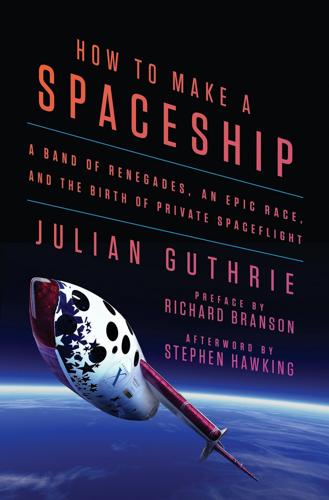
How to Make a Spaceship: A Band of Renegades, an Epic Race, and the Birth of Private Spaceflight
by
Julian Guthrie
Published 19 Sep 2016
Suddenly, Mission Control lost its connection to SpaceShipOne. Paul Allen could see a change in the team’s body language. Burt and Doug leaned forward in their chairs. “Ground to SpaceShipOne,” Doug said. Nothing. “Ground to SpaceShipOne.” No response. Doug’s lips trembled slightly. “Ground to White Knight. Contact SpaceShipOne.” Still nothing. “WhiteKnight to SpaceShipOne.” A few moments later, Mike, now desperate for a solution, decided to try the trim system again. This time, for a reason he couldn’t understand, the left stabilizer moved.* Oh my God—it worked, Mike thought. “SpaceShipOne to ground,” Mike said, as a collective sigh of relief was heard in Mission Control.
…
Dave Moore After a lifetime of dreaming, Peter Diamandis (right) and his father, Harry, watch the winner-takes-all flight of SpaceShipOne on October 4, 2004. October 4 was chosen by Burt Rutan to commemorate the anniversary of the launch of Sputnik (1957), the world’s first artificial satellite to orbit Earth. Peter Diamandis The White Knight, carrying SpaceShipOne, takes off for its XPRIZE flight. Mark Greenberg As thousands of spectators cheer, SpaceShipOne pilot Brian Binnie comes in for a landing to try to win the $10 million XPRIZE. Mark Greenberg Richard Branson (in white shirt) hugs Burt Rutan after SpaceShipOne wins the XPRIZE. For both men, the day heralded a new era for commercial spaceflight.
…
— On Wednesday, December 17, 2003, one hundred years to the day after two bicycle mechanics named Wright managed a powered and sustained flight in a flimsy aircraft that no one thought would fly, a bunch of “motorcycle mechanics in the desert” were ready for the first powered flight of SpaceShipOne. The White Knight and SpaceShipOne were rolled from the hangar of Scaled into the early morning light. The plan for the flight was straightforward: achieve a fifteen-second burn of the rocket motor and supersonic flight. Brian would assess how the motor lit and performed, how it felt going through transonics, and how the feather did at a relatively high altitude. Of these things, the sound barrier posed the greatest challenge. The little craft with the pointed nose sprinkled with oregano had never flown so fast or so high. Brian was in the cockpit of SpaceShipOne, to be carried aloft by the White Knight.
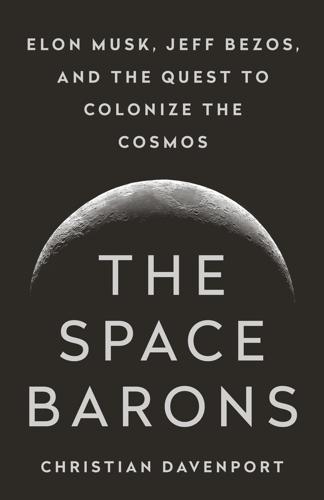
The Space Barons: Elon Musk, Jeff Bezos, and the Quest to Colonize the Cosmos
by
Christian Davenport
Published 20 Mar 2018
See also Beal Aerospace; Blue Origin; SpaceX; United Launch Alliance; Virgin Galactic Propulsion Module 2, 168–169 Purdue University, 249–250 railgun technology, 23 rapid unscheduled disassembly (RUD), 203 Rather, Dan, 68 real estate market: Andy Beal’s fortune, 30–31 regulating the private space industry, 118, 124–126, 153 remotely operated vehicles (ROVs), 193, 197–198 Ressi, Adeo, 38 reusable launch vehicles (RLVs), 199–200 reusable rockets Blue Origin’s successful launch and landing, 222–224 developing spaceplanes and shuttles, 268–269 fueling private funding for SpaceX, 249 history of, 25 importance of, 24 landings, 3 launch technology, 270–271 Saturn V rocket recovery, 190–191 Reynolds, Alastair, 76 risk as part of the American way, 122–124 rocket technology Beal advocating for private space programs, 32–33 Beal Aerospace, 30–32 Bezos-Musk discussions over rocket architecture, 55–57 Bezos’s fascination with, 21–24 Blue Origin’s development stages, 261–263 Musk’s Falcon 1 rocket unveiling, 42–44 Musk’s goal of improving launch capability and reliability, 40–41 Musk’s projected Mars travel, 242–245 Musk’s rivalry with Bezos over orbital launch, 229–230, 233–235 New Shepard’s self-guiding system, 222–223 origins and growth of SpaceX, 41–43 See also specific rockets and programs Rocketplane Kistler, 137, 140–141 Rohrabacher, Dana, 245 Rolling Stones, 106 Rose, Charlie, 26, 75 Russia Atlas V rocket, 206 costs of the space program, 160 decline of NASA programs, 157–158 Musk’s search for rockets, 40 shuttle service, 173 Rutan, Burt, 79–90, 92–94, 96, 108, 112, 116, 212–213 sabotage accusations: SpaceX explosion, 242 safety concerns Branson’s trans-Atlantic balloon flight, 101–102 informed consent standards, 118–119 Mars travel, 243–244 people’s lack of concern over space travel safety, 113 regulating the emerging commercial industry, 118 space shuttle disasters, 117 SpaceShipOne, 93 Tuckerman Ravine, 119 See also death Sarsfield, Liam, 45–48 satellite technology Beal Aerospace, 31–32 Defense satellite launch contracts, 52–54 launching infrastructure and technology, 268–269 national security responsibilities, 52–53 shrinking size and increasing affordability of satellites, 249 SpaceX explosion destroying satellite cargo, 239–241 Sputnik launch, 59–60 surveillance, 267–268 tracking asteroid collisions, 36–37 Saturn V rocket, 66, 129, 172, 188–192 Scaled Composites, 231 creation of, 80 kinks in the SpaceShipOne design, 93 Melvill’s SpaceShipOne test flight, 87–91 pilot rivalries, 82–83, 86–87 second flight of SpaceShipOne, 87 skepticism of, 86 SpaceShipOne crash, 82–84 SpaceShipTwo crash, 212–214 Virgin GlobalFlyer, 107 See also SpaceShipOne Schatz, Tom, 49 Schirra, Martin M., Jr., 173 Schmidt, Eric, 249 science fiction literature, Jeff Bezos’s love of, 64–65 Scott, Robert Falcon, 103 Seabed Worker (salvage ship), 187–188, 192–195 Seattle Museum of Flight, 254 self-guided rocket systems, 222–223 September 11, 2001, 52, 127 Seveneves (Stephenson), 24 Sex Pistols, 105 Shackleton, Ernest, 119 Shelby, Richard, 160 Shepard, Alan, 274 Shotwell, Gwynne, 48, 132–134, 137, 141–142, 154–155, 229, 240, 248 shuttle programs, 268–269 Columbia explosion, 41, 43, 96, 117 decline of NASA’s program, 85–86, 96, 172–173 increasing reliance on the private sector, 160–161 Musk’s interest in creating, 38–39 NASA’s Space Launch Initiative, 33 Siebold, Peter, 80–81, 86–89, 92–93, 95, 212–214 Simpson, Larry, 20, 24–25 60 Minutes (television program), 68, 106, 204 smoking, 63–64 social media Musk’s rivalry with Bezos over orbital launch, 229–230 rocket landings, 3 SpaceX explosion destroying satellite cargo, 239–241 SpaceX site, 204 See also Twitter sonar search of the ocean floor, 191–192 sonic boom, 22–23 Soviet Union Bezos’s acquisition of artifacts from, 72 Branson’s offer to go into space, 107 Sputnik launch, 59–60 space exploration and colonization as human survival, 32 asteroid habitation, 71 Blue Origin startup, 74 O’Neill’s proposal for, 67–71 See also asteroids; Mars colonization and missions; moon colonization and missions Space Launch Initiative, 33 Space Launch System (SLS), 244–245 space memorabilia, 251–252 space race, early, 235 ‘space’ versus ‘orbit,’ 224–225 spaceplane development, 79–80, 269.
…
TIMELINE September 2000 Jeff Bezos founds Blue Operations LLC, the precursor to Blue Origin. March 2002 Elon Musk incorporates Space Exploration Technologies. December 2003 First powered flight of SpaceShipOne. December 2003 Musk shows off the Falcon 1 rocket in Washington, DC. September 2004 Richard Branson acquires technology behind SpaceShipOne and vows to create the world’s first commercial spaceline with first flights in 2007. October 2004 SpaceShipOne wins the Ansari X Prize. March 2005 Blue Origin flies Charon, its first test vehicle, to 316 feet. March 2006 SpaceX attempts first launch of Falcon 1, which fails. August 2006 NASA awards SpaceX a $278 million contract as part of the Commercial Orbital Transportation Services program.
…
Perhaps most famously, Chuck Yeager’s Bell X-1 was air launched from a Boeing B-29 before he became the first person to break the sound barrier in 1947 over the same Mojave Desert where SpaceShipOne would fly. But unlike other air-launched vehicles, Rutan had a special design for SpaceShipOne, an idea that had come to him in the middle of the night. Essentially, the spaceplane’s wings would be able to detach from the body of the plane and fold upward in what he called a “feather” maneuver. The upright wings would act like the feathers of a badminton shuttlecock, centering the plane by creating drag for a reentry into Earth’s atmosphere so soft that it eliminated the need for a heat shield. Once SpaceShipOne was safely back in the dense air of the atmosphere, the wings would fold back down, and the aircraft would glide back to the ground.
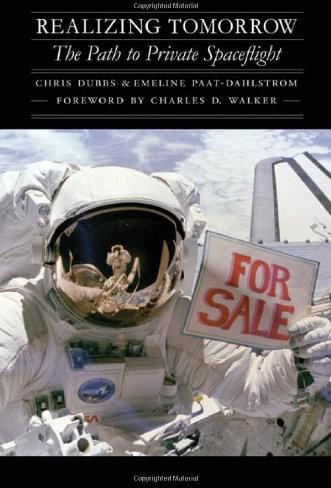
Realizing Tomorrow: The Path to Private Spaceflight
by
Chris Dubbs
,
Emeline Paat-dahlstrom
and
Charles D. Walker
Published 1 Jun 2011
Peter Diamandis and Bob Richards, September 2002 24. Rocket models Of X PRIZE competing teams 25. Brian Feeney at the 2005 X Cup 26. Burt Rutan with a model of SpaceShipOne 27. SpaceShipOne attached to White Knight z8. Mission control at Scaled Composites 29. Mike Melvill riding on top of SpaceShipOne 30. Brian Binnie and Mike Melvill in front of SpaceShipOne 31. Ansari x PRIZE successful flight celebration 32. Per Wimmer with models of WhiteKnightTwo and SpaceShipTwo 33. Sir Richard Branson standing beside SpaceShipOne, 2I June zoo4 34. Sir Richard Branson with Burt Rutan during rollout of WhiteKnightTwo 35. Elon Musk in front of Falcon 9 engines, 8 January zoo9 36.
…
Burt Rutan, chief designer and founder of Scaled Composites, holds a model of SpaceShipOne. Photograph by Mark Greenberg, courtesy of Virgin Galactic. 27. SpaceShipOne attached to White Knight prior to its first suborbital flight over Mojave, California. Courtesy of Scaled Composites. 28. Mission control at Scaled Composites during the first private suborbital flight. Courtesy of Scaled Composites. 29. Mike Melvill riding on top of SpaceShipOne after the first successful suborbital flight. Courtesy of Robert Pearlman, collectsnncE.com. 30. Brian Binnie and Mike Melvill in front of SpaceShipOne. Photograph by Mike Mills, courtesy of Virgin Galactic. 31.
…
Such was Rutan's reputation that this unveiling event drew the likes of Buzz Aldrin, first space tourist Dennis Tito, adventurer Steve Fossett, Air Force brigadier general Pete Worden, Peter Diamandis, Erik Lindbergh, and considerable media. Rutan's long-awaited entry into the x PRIZE competition turned out to be not one but two new craft, SpaceShipOne, a rocket-powered, suborbital aircraft, and White Knight, the mother ship that would carry SpaceShipOne aloft under its fuselage and launch it from fifty thousand feet. Once clear of the aircraft, SpaceShipOne would fire its single-rocket engine and soar into a steep, eighty-four-degree climb to an altitude of one hundred kilometers, the widely accepted boundary of space. The craft would then glide back to Earth for a runway landing.
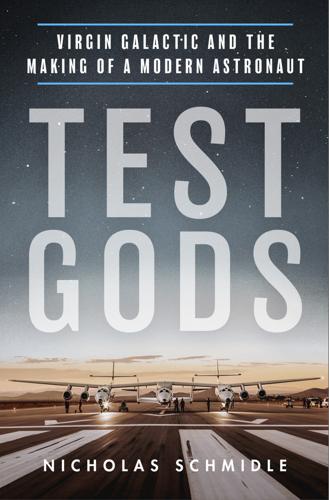
Test Gods: Virgin Galactic and the Making of a Modern Astronaut
by
Nicholas Schmidle
Published 3 May 2021
See also rocket motors Rodgers, June Scobee Rosepink, Deborah Rosepink, Ron rubber-fuel design motor Russia Rutan, Burt Allen and Branson and Branson honors Colby and “cold flow” test explosion and documentary about NASA and Presidential Citizen’s Medal received from Reagan receives medallion from Aero Club de France rocket-powered flight test and Schmidle’s “Rocket Man” profile of Stucky in New Yorker and SkiGull and SpaceShipOne and Stucky and takes medical leave Trump and wins X Prize Rutan, Tonya Sagan, Carl Salina, Kansas Saling, Michelle Salter, James, The Hunters Salty Dogs SAPs (special-access programs) Saturn IB Saturn V Saudi Arabia Scaled Composites accused of sloppiness “cold flow” test explosion at crash of SpaceShipTwo and as engineering cult design of SpaceShipOne and party in 2009 and PR and rocket-powered flight test Rutan’s philosophy at SETP tour and SpaceShipOne and SpaceShipTwo and Stucky and Virgin Galactic and Schmidle, Bohan Schmidle, Nicholas (author) background of centrifuge training and at ceremony honoring Stucky and Sturckow childhood of compartmentalization and embeds with Virgin Galactic field trip to Mojave and in Idaho invited to Virgin Islands by Branson meets Stucky in Pakistan Patterson and “Rocket Man” Shane and Stucky and Sturckow and takes sons to National Air and Space Museum trip to Mojave with family Virgin Galactic’s adversarial turn against writing for New Yorker Schmidle, Oscar Schmidle, Pamela Schmidle, Robert (“Rooster”) in Bosnia at ceremony honoring Stucky and Sturckow goes down over Japan Gulf War and receives Distinguished Flying Cross return from Gulf War Stucky and Sturckow and Schwarzenegger, Arnold science Scobee, Dick “scoot shelters” Scott, David scramjets SCUM truck (Scaled Composite Unit Mobile) Seguin, Elliot September eleventh attacks Sex Pistols Shane, Doug Shenzhou Shepard, Alan Shotwell, Gwynne Siebold, Peter Siebold, Traci Sierra Nevada Corporation SkiGull Skunk Works Smith, Michael Smith, Ned Abel Society of Experimental Test Pilots solar wind Soviet Union.
…
His mother-in-law spilled coffee on him the next morning. Thousands of people came to watch. Binnie sat in SpaceShipOne while White Knight carried him to altitude. He felt nervous and scared of screwing up but told himself that his fear was proof that he cared. White Knight dropped him and he lit the rocket. It was loud and chaotic. The boost felt like a wave that might sweep him away, but when the rocket burned out the vibrations stopped. “All the tension melts,” said Binnie. Mike Melvill (standing) after SpaceShipOne’s first successful space flight, with Paul Allen (left) and Burt Rutan. He looked out at the inky blackness beyond his windows, the edge of the atmosphere a mere ribbon of blue light on the horizon.
…
“Nobody complains about making noise or sending plumes into the sky,” said one aerospace engineer in Mojave. “This is the Silicon Valley for the new industry.” Branson had his own impossible idea. He wanted Rutan to build him a rocket for tourists—just like SpaceShipOne, but bigger. Branson had paid a million dollars to Paul Allen to put a Virgin decal on SpaceShipOne, gaining the right to one day adapt the design for tourists. But he couldn’t do that without Rutan. Rutan was tempted, though it felt a little too much like certification and production for his liking. He preferred to spend his energy on novelties.
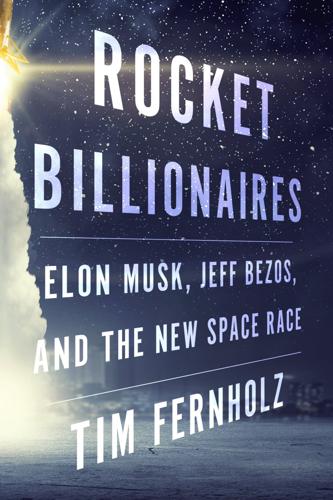
Rocket Billionaires: Elon Musk, Jeff Bezos, and the New Space Race
by
Tim Fernholz
Published 20 Mar 2018
Rutan’s key innovation was a large rotating wing that would “feather” upward as the space plane entered the atmosphere. This would force SpaceShipOne to fly belly first, akin to a falling badminton shuttlecock. In 2000, after several years of talk, Rutan convinced Allen that this design would succeed. The billionaire funded a joint venture to build SpaceShipOne and win the X Prize. Allen would eventually put $20 million into the project; he hoped to jump-start a new age of commercial space. In the summer of 2004, the space shuttle was still grounded when Scaled Composites’ sixty-four-year-old test pilot Mike Melvill pulled the lever that dropped SpaceShipOne from its mother ship. He rocketed into space for the first time, reaching an altitude of just over a hundred kilometers.
…
—Michael Griffin, former NASA administrator On October 4, 2004, Paul Allen’s largesse and Burt Rutan’s know-how put the first privately funded, reusable, human-carrying vehicle into space twice in one week. The space shuttle program was still on the ground. SpaceShipOne was constructed by Scaled Composites, Rutan’s Mojave-based experimental aircraft company. He was the kind of guy who sported silver mutton chops, lived in a hexagonal pyramid house of his own design, and did his own research into the JFK assassination. His company specialized in pushing limits: building a plane capable of a nonstop flight around the world and designing kits for hobbyists to build their own lightweight aircraft. Scaled will be remembered for SpaceShipOne and winning Peter Diamandis’s $10 million X Prize, demonstrating that a private company could put people into space without government help.
…
To satisfy the requirements of the prize, SpaceShipOne would need to fly with six hundred pounds of ballast, equivalent to two passengers plus the pilot. As it stood, the rocket motor on the vehicle would not get the vehicle high enough, and indeed might leave it with a trajectory that came dangerously close to populated areas. Scrambling for a solution, Rutan settled on air-to-air missiles like the Sidewinder and the AMRAAM, which were essentially small solid fuel rockets launched by NATO fighter jets during aerial battles. Two such missiles, with their warheads removed, attached to SpaceShipOne at the correct angle and fired at exactly the same time, could hypothetically provide enough oomph to get the vehicle over its invisible finish line in the sky.

Beyond: Our Future in Space
by
Chris Impey
Published 12 Apr 2015
His clever solution was inspired by the way a badminton shuttlecock automatically orients itself correctly with the direction of flight. Allen and Rutan became partners, and SpaceShipOne started taking shape in the California desert (Figure 18). In keeping with his ethos of intuitive, hands-on engineering, Rutan tested the stability of SpaceShipOne by throwing a model off a tower. In June 2004, a crowd of 10,000 people watched Rutan’s mother ship, White Knight, haul SpaceShipOne up into the sky. It became the first manned civilian vehicle to reach an altitude of 100 kilometers. In September of that year, SpaceShipOne won the X Prize with two flights five days apart. The only sour note came with an argument between Rutan and Allen—the investor wanted the press but not the public to see the launch.
…
Characteristically, he reacted to his troubles by reaching even higher, getting into a challenging business that had no track record at all—space travel. He said he was inspired to think about space travel by a question he was asked on a BBC children’s TV show in 1988. Branson founded Virgin Galactic in 2004 and then commissioned Burt Rutan to scale up his SpaceShipOne design to be suitable for space tourism. Whereas SpaceShipOne had one pilot, SpaceShipTwo carries two pilots and six passengers. The carrier aircraft, White Knight II, will take off from a custom-built facility in New Mexico, with a 10,000-foot runway and a suitably “space age” terminal building. At an altitude of 52,000 feet, SpaceShipTwo will rocket upward to just over 100 kilometers, or 60 miles, where the curved limb of the Earth will be visible and the sky will be jet black.
…
They flew 199 missions. One pilot was lost when his plane went into a hypersonic spin and broke apart at 60,000 feet, scattering wreckage over 50 square miles. The only other spaceplanes so far have been NASA’s Space Shuttle, its Russian counterpart Buran (which flew once, in 1988), Burt Rutan’s SpaceShipOne (which flew seventeen times between 2003 and 2004 and is discussed in chapter 5), and the X-37. The X-37 is a project to demonstrate reusable space technologies. It began in 1999 under the Air Force and was transferred to NASA in 2004. Think of it as a more advanced but smaller and unmanned version of the Space Shuttle.
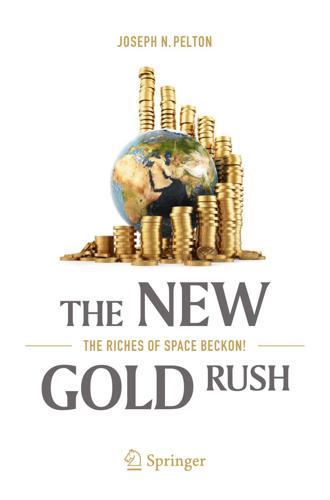
The New Gold Rush: The Riches of Space Beckon!
by
Joseph N. Pelton
Published 5 Nov 2016
The Rutan team designed the SpaceShipOne spaceplane system that flew into space to an altitude above 100 km and then flew again with a crew within a 5-day period to meet the contest requirements. When the second flight landed on October 4, 2004, an impromptu sign was held up within the crowd that had assembled in the Mojave Desert: “SpaceShipOne, NASA None” (see Fig. 4.3). Fig. 4.3 SpaceShipOne on display at the Smithsonian National Air & Space Museum after its historic flight on October 4, 2004 (Image courtesy of the National Air and Space Museum.) From the start, the SpaceShipOne flight and the Ansari XPrize was based on an unconventional start-up entrepreneurial model.
…
S. regulatory actions Space Mission Planning Advisory Group (SMPAG) Space navigation Space R&D programs Space Resource Exploration and Utilization Act of 2015 common heritage of mankind global commons legal enforcement outer space change policing regulatory system Sentinel infrared telescope space colonies traffic control and management Space Resource Utilization Space Swiss Systems (S3) Space tourism Space transportation ICAO radiation danger radio frequencies, allocation of SARPS traffic management and control Space-based navigation Space-based war-fighting systems SpaceHab Spaceplane system aerospace organizations safe and non-polluting development Space Ship 2 Space Swiss Systems (S3) SpaceShipOne and space tourism SpaceShipOne SpaceShipTwo Star wars Stratobus Stratolaunch Subspace/protospace Super automation Super urbanization Syncom 2 T TASI SeeTime Assignment Speech Interpolation (TASI) TDRS SeeTracking and Data Relay Satellite (TDRS) system Ten Point Program the global commons global population control humanity laws and regulation mega-structures and intellectual infrastructure planetary protection programs singularity space- and ground-based infrastructure sustainability urban sprawl Time and human technological progress Time Assignment Speech Interpolation (TASI) Tiny 40-kg Early Bird satellite Tracking and Data Relay Satellite (TDRS) system Transformational Satellite System (TSat) Transitional satellite (TSAT) Treaty on Principles Governing the Activities of States in the Exploration and Use of Outer Space Tripartite space governance unit TSat SeeTransformational Satellite System (TSat) TSAT SeeTransitional satellite (TSAT) U U.
…
The rest of us will go to Mars.” The New Space Billionaires Peter Diamandis is not alone in his thinking. From the list of “visionaries” quoted earlier, Elon Musk, the founder of SpaceX; Sir Richard Branson, the founder of Virgin Galactic; and Paul Allen, the co-founder of Microsoft and the man who financed SpaceShipOne, the world’s first successful spaceplane have all said the future will include a vibrant new space economy. They, and others, have said that we can, we should and we soon shall go into space and realize the bounty that it can offer to us. The New Space enterprise is today indeed being led by those so-called space billionaires , who have an exciting vision of the future.

Bold: How to Go Big, Create Wealth and Impact the World
by
Peter H. Diamandis
and
Steven Kotler
Published 3 Feb 2015
Over the next fifteen years, he took the company to over $600 million in cumulative revenues—and if you’ve ever tried to sell a $50 million seat into orbit or a $150 million ride around the Moon, you’ll respect the achievement. Others, impatient for this same dream, took a different approach. On October 4, 2004, when aviation legend Burt Rutan won the $10 million Ansari XPRIZE with SpaceShipOne, Sir Richard Branson swooped in to license the winning technology, committing a quarter of a billion dollars to develop Virgin Galactic’s SpaceShipTwo—the commercial follow-up to SpaceShipOne.4 Next, Amazon founder Jeff Bezos committed over $100 million toward a secretive launch vehicle company called Blue Origin.5 Perhaps most impressive was PayPal cofounder-turned-aerospace-disrupter Elon Musk, whose epic success with the Falcon 9 launch vehicle and Dragon capsule placed him in the category of “space god” and earned him a multibillion-dollar contract from NASA to ferry cargo to the International Space Station.6 Certainly, these were all amazing successes, but, in the summer of 2009, when I got together with Eric for our annual “What’s Next?”
…
Branson also bets big, but because he’s risking his entire brand (Virgin) versus a singular company (Tesla), he manages to do this is a way that doesn’t jeopardize the empire. Virgin Galactic is a fantastic example. In October 2004, when Burt Rutan demonstrated the success of the three-passenger SpaceShipOne vehicle, winning the Ansari XPRIZE, Branson and his team came in with a multi-hundred-million-dollar commitment to scale that design up to an eight-passenger vehicle able to make multiple flights per day and carry thousands into space per year. But, as is Branson’s style, in 2009, he was brilliantly able to offset that risk by bringing in Aabar, the Mideast investment fund, to purchase 32 percent of Virgin Galactic for $280 million.19 Then, two years later, Aabar increased their stake by 6 percent, committing an additional $110 million to fund small satellite launch capability.20 So, sure, Branson bet a huge amount on Virgin Galactic, but he then protected that investment and brought in an extra $390 million in working capital to ensure its success.
…
How to achieve a goal without specifying the exact process and how to avoid a false wins (i.e., that micro-motor built from conventional tools). At the beginning of a competition, we propose a set of guidelines that are publically distributed and open for comment. There is extensive discussion with the teams and then, months later, the guidelines are converted into a final set of rules. At the unveiling of SpaceShipOne, Burt Rutan noted, “It’s amazing that the rules for the XPRIZE are still valid today, nearly eight years after they were announced in 1996.” This was an important lesson. The Step-by-Step How-To of Your Incentive Competition With all of the parameters above in mind, now it’s time to design, build, and launch your own challenge.

Adapt: Why Success Always Starts With Failure
by
Tim Harford
Published 1 Jun 2011
The AMC delivers vaccines’, Center for Global Development, Global Health Policy blog, 13 December 2010: http://blogs.cgdev.org/globalhealth/2010/12/break-out-the-cham-pagne-the-amc-delivers-vaccines.php 111 Prize enthusiasts think that even an HIV vaccine: THarford, ‘Cash for answers’, FT Magazine, 26 January 2008, http://timhar-ford.com/2008/01/cash-for-answers/ 112 ‘Innovation is what we do because there’s nothing else to do in Mojave’: Leonard David, ‘Brave New World? Next steps planned for private space travel’, Space.com 06 October 2004, http://www.space.com/news/beyond_spaceshipone_041006.html 112 The age of private space flight: Ian Parker, Annals of Aeronautics, ‘The X Prize’, The New Yorker, 4 October 2004; and also see the Discovery Channel footage of SpaceShipOne Flight 15P, for instance at: http://www.youtube.com/watch?v=29uQ6fjEozI 114 When first reaching the brink of space: Leonard David, ‘Brave New World? Next steps planned for private space travel’, Space.com 06 October 2004, http://www.space.com/news/beyond_space-shipone_041006.html 4 Finding what works for the poor or: Selection 115 ‘An empiricist, I was willing’: Muhammad Yunus & Alan Jolis, Banker to the Poor (London: Aurum Press, 1999), p. 65. 115 ‘The barrier to change’: Bill Gates, Harvard University Commencement Address, 2007, http://ow.ly/JwQH 115 ‘They were everywhere, lying very quiet’: Yunus & Jolis, Banker to the Poor, p. 3. 117 His facility for pragmatic problem-solving: Yunus & Jolis, Banker to the Poor, p. 31. 117 Nor is Grameen the world’s largest microfinance lender: ‘The hidden wealth of the poor’, The Economist, 3 November 2005, http://www.economist.com/surveys/displaystory.cfm?
…
White Knight One had been developed by the brilliant aircraft designer Burt Rutan, a genius in the mould of Mitchell, in the Galapagan olation of a tiny desert town with a scattering of fast-food joints and gas stations and a vast parking lot for disused commercial airliners. (Says Rutan, ‘Innovation is what we do because there’s nothing else to do in Mojave.’) Slung under that eggshell-wing, between White Knight’s catamaran-style twin hulls, was a stubby little appendage, SpaceShipOne. Inside it sat a 63-year-old man named Mike Melvill. The age of private space flight – and with it the potential for space tourism – was about to dawn. On the face of it, innovation prizes deserve credit for this epochal event. White Knight was one of two dozen competitors trying to win the Ansari X Prize, created by a non-profit foundation.
…
However we hand out the credit for Mike Melvill’s flight, it must have been a journey to remember. White Knight took off at 6.47 a.m. and over the next hour climbed to a height of almost nine miles, higher than any commercial airliner could reach. White Knight then released Melvill and his craft, which glided for a moment before Melvill fired its rocket engine. SpaceShipOne curved sharply upwards until travelling nearly vertically. It accelerated past the speed of sound within ten seconds; after seventy-six seconds, the engine shut down automatically. The ship, already over 30 miles or 50 kilometres up, continued to hurtle through the ever sparser atmosphere at over 2000 miles an hour until it reached, just barely, the 100-kilometre mark that is accepted to be the point at which space begins.
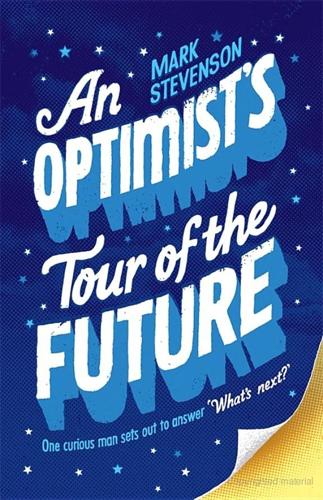
An Optimist's Tour of the Future
by
Mark Stevenson
Published 4 Dec 2010
Still, it was here that Richard Branson’s Virgin Galactic grabbed headlines in 2004 by launching SpaceShipOne, winning the $10 million Ansari X Prize for Spaceflight, offered to the first commercial vessel able to take three people over the Kármán line and return them to Earth twice in fourteen days. The total cost of this entire development was rumoured at between twenty and thirty million dollars, which as far as the history of human spaceflight goes is peanuts. It’s also peanuts in relation to aviation, given the $330 million list price of an Airbus A380 (of which Virgin Atlantic have six on order). It has to be said that SpaceShipOne was a ‘suborbital’ vehicle that took only short hops into space, but nonetheless the price was impressively low.
…
Greason remarked that their findings departed from previous presidential commissions on the future of US space exploration not by recommending anything radically different but because ‘some people actually paid attention this time.’ Part of the reason, no doubt, is the Space Shuttle’s 2011 retirement date. With no launch vehicle immediately to replace it, NASA must look to commercial providers to get its hardware and astronauts into orbit (if only to staff the International Space Station). Another reason was that SpaceShipOne provided a real-world demonstration of cheap commercial spaceflight. A number of commercial spaceflight companies have popped up in the last decade, most funded by billionaires looking for a new challenge and/or some ego food. Some are beginning to do serious business. Los Angeles-based SpaceX (founded in 2002 by PayPal founder Elon Musk) has already secured launch contracts from NASA and commercial satellite developers.
…
Daniel 160, 164 Hitchhiker’s Guide to the Galaxy, The 100 Hoek, Eric 118 Hofmeister, Anke 261–2 Hofstadter, Douglas 276 Holbrook 221–2, 239–40 Huggable 78 Human Security Brief 148 Huntington’s disease 44, 58 Huxley, Julian 13 I IBM 113, 125 identical twins 43 Imperial College London 31, 213 indium 195–6 Industrial Revolution 110, 115, 167, 171, 284–5 inequality 302 influenza virus 64–5, 69–70 Insomnia Cookies 93–4 Institute for Health Metrics and Evaluation 149 Institute of Bioengineering and Nanotechnology 69 Intelligent, Safe and Smart Built (ISSB) 119 interconnectedness Internet 151–8 nonzero-sum game 149–51 telegraph 145–7 and violent deaths 149 Intergovernmental Panel on Climate Change (IPCC) 171, 172, 179, 180 International Association Synthetic Biology 68 International Gene Synthesis Consortium 68 Internet 147, 151–64, 268, 302 invariants 99 Iran 157 Isasi, Rosario 27 IVF 106 J Jackson, Ron 64 Jones, Richard 120–1, 124, 130 Joule Biotechnologies 57, 186–8, 189 JSB see Brown, John Seely Jungerbluth, Philip 20 Jurassic Park 39, 75 K Kahn, Bob 153, 159 Kármán line 133 Kasparov, Garry 82, 83, 86 Katter, Bob 171 Keeley, Lawrence 147 Keeling, Charles David 167 Keith, David 184 Kelly, Kevin 161 Kench, Paul 242 Kessler, Andy 43 Klein, Naomi 303 Kleinrock, Leonard 152 Kline, Charley 152 Knome 50 Konarka 190–1, 196–204, 206, 224, 295, 299 Kossel, Albrecht 37 Krummel, Glen 228 Kukla, George 178–9, 186 Kunfunadhoo Island 261–2, 266 Kurzweil, Ray 90, 267–78, 282, 293, 299, 303–4 and Brown, John Seely 285 posthumans 103–4, 268 The Singularity 88 transhumanism 21–2, 267–8 Kyrgyzstan 157 L Lackner, Klaus 173, 174–86, 188, 189, 259–60, 299, 301 Lana 224–5 Langley, Tim 212–19 Law of Accelerating Returns 51, 270–8, 293 Leber’s congenital amaurosis (LCA) 59–60 Legion of Extraordinary Dancers 155, 158, 294 Lehmann, Johannes 209–10 Leo 73–4, 75–6, 79, 80–2, 84–6, 102 Lewis, Dan 203 Licht, Stuart 184 life expectancy 12–13, 301 and income 27–8 longevity escape velocity 29–30 limited liability corporations 290–1 Lincoln, Abraham 265–6 Lipson, Hod 92, 94–6, 98–101, 102, 210, 272–3, 293, 299 longevity escape velocity 29–30 López, José 117 Lovell, Tony 222–40, 300 Lovelock, James 164, 172, 220 biochar 208–9, 210, 215 LS9 56–7, 61 Lynx spaceplane 142 M Maahlos 261 McConnell, James 17 MacDiarmid, Alan 196 ‘Machine Stops, The’ (Forster) 161 McNamara, Kaitlyne 20–1 Maes, Pattie 162–3 Maldives 241–62 Malé 249–50 Malthus, Thomas Robert 250 ‘Manchester Report, The’ 223, 224 Markram, Henry 90, 91 Martine, George 252–3 Masten Space Systems 136 Matrix, The 103 men life expectancy 12, 23 pregnancy 24 methane 230 Methuselah Foundation 21 Mexico 278–9 Miescher, Johannes Friedrich 37 Miller, Webb 41 Minsky, Marvin 102, 104 Miromatrix Medical 20 MIT 40, 262 Fluid Interfaces Group 162–3 Media Lab 77–8 nanotechnology 201 Smart Cities Group 200 Technology Review 16, 187 Mitchell, Bill 200 Mojave 131–3, 135–44 Monbiot, George 215, 303 Moombril 221–2, 239–40 Moore, Michael 303 Moorhead, Paul 18 Moravec, Hans 74, 84, 89–90 Morgan Stanley 193 Mosely, Andrew 231–5 Mosely, Megan 231–5 Mouchot, Augustin 192–3, 266 mousepox 63–4 Musk, Elon 136, 141 Myhrvold, Nathan 16 N Najning University 120 nanofactories 114–17, 125–6, 286 Nanoforum 120 nanoparticles 287 nanopunk 117 Nanosolar 202–3 Nanosystems (Drexler) 112, 124 nanotechnology 107, 108–30, 268, 301, 302 apocalypse 125–7 and energy 201 Grey Goo 121–3 products 117–21 Narrandera 237–8 NASA 134, 135, 136, 141, 170 Nasheed, Mohamed 243–9, 254–60, 262 National Academy of Engineering 125 National Academy of Sciences 125 National Center for Atmospheric Research 176 National Center for Biotechnology Information (NCBI) 64–5 National Human Genome Research Institute 36 National Research Council 125 National Science Advisory Board for Biosecurity 67–8 natural language 86–7 Nature 170 Near-Earth Asteroid Rendezvous (NEAR) 134 New Scientist 68 New York 172 New York University 120 New Zealand 206–20 New Zealand Wind Farms 208 Nexi 102 Niven, Larry 135 nonzero-sum games 149–51, 153–4, 270 Northwest Passage 177–8 Nouri, Ali 65 nuclein 37 O oil 193 Olovnikov, Alexey 52–3 Olshansky, Stuart Jay 12 oncogenes 46–7 optical telegraph 145–6 Optimist (cocktail) 220 organic conductive polymers 196–7, 198, 201 ornithine transcarbamylase deficiency 58–9 Ott, Harold 20 over-population 17–18 P Pakistan 157 Pan Am 133 parabolic surfaces 192 Parkinson’s disease 273–4 Partners in Health (PIH) 202 Personal Genome Project (PGP) 37, 42–3, 47–50, 51, 273 Personal Robots Group 73–4, 75–6, 77–82, 84–6, 102 Pew Charitable Trusts 119 Pew Research Center 168 phenylketonuria 44, 58 Picton 214–15, 217–18, 220 Pifre, Abel 192 Pinatubo, Mount 169 Pinker, Steven 83, 147, 149, 293 Pirbright Laboratory 68 Pistorius, Oscar 29, 300 Pleasance, Erin 40–1 Polonator G.007 50 Pontin, James 16 Popular Science Monthly 192 population 17–18, 249–54 pornography 158 Portugal 234–5 Power Plastic 196–7, 198, 204, 224 Prey (Crichton) 122 procreative beneficence 23 Project on Emerging Nanotechnologies 119 proteins 45–6 ProtoLife 66 Pygmalion (Shaw) 86 pyrolysis 209–10, 212–14 R Ranchos de Taos, New Mexico 234 Rankin, Sarah 31 Rasmussen, Lars 256 Rebek, Julius 124 reflection 86 Regis, Ed 112 Reicher, Dan 194–5 Rema 199 Reporters Without Borders 157 Revue des Deux Mondes 192 Rice University 118–19, 201 Ridley, Matt 270, 302–3 Roberts, Lawrence 152 Roberts, Paul 244, 248, 254 Robinson, Ken 265–6, 284, 288, 293 robots 73–92, 302 Leo 73–4, 75–6, 79, 80–2, 84–6 Nexi 102 Starfish 95–6, 98–9 Rofecoxib 49 Rosenthal, Elisabeth 254 Rosling, Hans 251, 254, 293 Rothemund, Paul 119, 120 Ruddiman, William 230 Rumsfeld, Donald 172 Rutan, Dick 140–1, 142, 143 S Sanger Institute 40–1, 51 Saudi Arabia 157 Savory, Allan 221, 226–7, 232 Savulescu, Julian 23 scalable efficiency 286 Scaled Composites 136, 139, 142 Schmidt, Michael 98, 99, 273 Schöni, Peter 220 Schuster, Stephen 41 Schweizer, Erhard 113 scientific method 96–8 self-replication 121–3 senescence 18, 53–4 Shadow Robot Company 74–5 Sharkey, Noel 76–7 Sharpe, Tom 256 Shaw, George Bernard 86 Shawcross, Lord 215 Shew, Ashley 109–10 Shirakawa, Hideki 196 Shivdasani, Eva 261 Shivdasani, Sonu 261 Siemens 193 silicon cells 195–7 Singularity 88, 268 Singularity is Near, The 268, 269, 271 Six Million Dollar Man, The 14 SixthSense 162–3 Skordalakes, Emmanuel 52, 53 Smalley, Richard 111, 122, 123, 201 SmartHand 103 Smolker, Rachel 216 Snider, Wayne 200 Socrates 96–7, 99 soil carbon 228–31, 233–5, 236–7, 238 soil charcoal 213–14 solar energy 190–1, 192–3, 194–205, 206, 274, 295, 302 Solar Thermal Electrochemical Photo Carbon Capture 184 Solarbuzz 205 Soneva Fushi 261–2 space 133–44, 302 Space Frontier Foundation 134 SpaceShipOne 135–6 SpaceShipTwo 136, 139, 142 SpaceX 136, 141 Sparrow, Rob 23–4 Speedy, Barb 218 Spielberg, Steven 75 Stan Winston Studio 75 Standage, Tom 146–7 Stanford University 20 Star Wars 76, 83, 102 Starfish 95–6, 98–9 Stark, Philip 158 Stellenbosch University 118 stem cells 19–21, 31, 301 Stiehl, Dan 78–9 Stoppard, Tom 281 Strong, Graham 237–8 StubbyGlove 228 Suel, Gurol 273 Suh, Yousin 53 Sun Tzu 40–1, 51–2 surveillance 127, 129 synthetic biology 55–8, 70 bacteria 56–8 bioterrorism 63–6, 68 control 66–70 genome engineering 60–3 viral gene therapy 58–60 Synthetic Genomics 56 Syria 157 Szostak, Jack 18 T Taylor, Doris 20 TED (Technology, Entertainment, Design) 14, 153, 265–6, 291–5 Tefera, Elfenesh 199 telegraph 145–7, 297, 301 tellurium 195–6 telomerase 18–19, 45, 52–4 Terminator, The 76, 78, 103, 302 Tetrahymena 18 Thornton, Edward 146 thymine 37–9, 46 Toffler, Alvin 289 Tofu 79 transhumanism 13–18, 21–34, 45, 52–4, 267–8 transplants 19–21 Treder, Mike 126–7 tribes 155–6 Tripathy, Sukant 199 truth 96–8 Tsiolkovsky, Konstantin 114, 116, 125, 128 Tufts Center for the Study of Drug Development 49 Tumlinson, Rick 133–4 Turing, Alan 88 Turkmenistan 157 Turney, Chris 213 twins 43 U underwater cabinet meeting 241–2, 245, 246–9, 258 Ungar, Georges 17 United Nations (UN) biosafety 68 Livestock’s Long Shadow 230 population 252 State of the World’s Forests 253 World Urbanisation Prospects 250 United States biofuels 187 carbon dioxide 184 electricity 285 global warming 168 oil 187, 188 science 279–80 space programme 134, 136 University of Bradford 149 University of Bristol 20 University of British Columbia 148 University of California 118–19 University of Maryland 201 University of Minnesota 20 University of Regensburg 125 University of Washington, Center for Conservation Biology 40 Uppsala University 148 Uzbekistan 157 V Venter, Craig 36, 47, 50, 56, 57, 58, 279 Vietnam 157 Vinsen, Mark 211–12 violence 147–51, 302 and interconnectedness 157–8 and Internet 244–5 and nanotechnology 126–7 Vioxx 49 viral gene therapy 58–60 Virgin Galactic 135–6, 141 vitrification 15 Voltaire 218 Voyager 140 W Wake Forest Institute for Regenerative Medicine 20 Wall-E 76 Ward, Bruce 222–40, 259, 300 wars 147–9 Watson, James 56 Web 154–5 Weitz, David 51 Weizenbaum, Joe 86 Weldon, Larry 190–1, 196–7 Wellcome Trust Sanger Institute 40–1, 51 Wemett, Tracy 190, 197, 204, 267, 276, 297 Wired 61, 112, 159 Witt, Stuart 137–40, 143, 144 women 23–4 Wonder, Stevie 269 wood gas 209 Woodrow Wilson International Center for Scholars 119 World Health Organisation 68, 69–70, 148, 149 World Transhumanist Association 25 worldchanging.com 158 Wright, Allen 179, 180 Wright, Burt 179, 180 Wright, Karen 224–5 Wright, Orville 132–3 Wright, Robert 149–51, 156, 158, 270, 293 Wright, Tim 224–5 Wright, Wilbur 132–3 X Xcel Energy 199, 200 XCOR Aerospace 136, 141–2 Y YouTube 155, 157, 294 Z Zhang, Jin 118 Zimbabwe 221, 226 Zittrain, Jonathan 153 Ziyad, Mohamed 254, 255–6 Zykov, Victor 95 * An interesting coda to Claudia’s story is that she nearly didn’t get her operation.
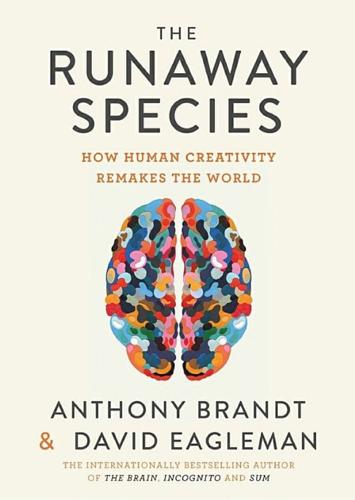
The Runaway Species: How Human Creativity Remakes the World
by
David Eagleman
and
Anthony Brandt
Published 30 Sep 2017
For the first XPrize in 2004, the goal was a reusable sub-orbital spacecraft: a $10 million award was offered to the first team who could fly a crew sixty miles high, twice within two weeks. Twenty-six crafts from around the world competed, with designs from rocket fins to airplane wings. The prize eventually went to Mojave Aerospace’s SpaceShipOne By spreading the net widely, realizing the dream of privatized space travel came a step closer. And this crowdsourcing strategy is becoming increasingly popular. When Netflix wanted to boost its algorithms for personalized movie suggestions, the company realized it would be cheaper to sponsor a $1 million global prize than do the work in-house.
…
. © 2016 Estate of Pablo Picasso / Artists Rights Society (ARS), New York Max Kulich’s sketches for the Audi CitySmoother Courtesy of Max Kulich The Architectural Reseasrch Office’s sketches for the Flea Theater in New York Courtesy of Architectural Research Office Joshua Davis’ skethes for IBM Watson Courtesy of Joshua Davis IBM Watson on the Jeopardy set Courtesy of Sony Pictures Television Advent, Thunderbird, Starchaser, Ascender, and Proteus Courtesy of the Ansari X-Prize Scaled Composite’s SpaceShipOne Courtesy of the Ansari X-Prize Chapter 9 Einstein blouses https://www.google.com/patents/USD101756 Sarah Burton: Kate Middleton wedding dress Photo by Kirsty Wigglesworth – WPA Pool/Getty Images Sarah Burton: three dresses from the Autumn/Winter 2011-12 Alexander McQueen ready-to-ware collection Photo by Francois Guillot, AFP, Getty Images Norman Bel Geddes: Motor Coach no. 2, Roadable Airplane, Aerial Restaurant and Walless House Courtesy of the Harry Ransom Center, the University of Texas at Austin © The Edith Lutyens and Norman Bel Geddes Foundation, Inc.
…
(Barbèy) ref1 Oldenburg, Claes ref1, ref2 Ono, Yoko ref1 open-office plans ref1 “The Open-Office Trap” (article) ref1 The Origins of Continents and Oceans (Wegener) ref1 orthogonal thinking ref1 Otherlab ref1 Otis Elevator Company ref1 “outward bound” model ref1 Painting (1954) (Guston) ref1 Palace of Versailles ref1 Palo Alto innovation center ref1, ref2 parachutes ref1 Paramount ref1 parasols ref1 Parks, Suzan-Lori ref1 Parliament (band) ref1 Patent Office (US) ref1 “Pay-to-See” system ref1 peanut crops ref1, ref2 Pegasus ref1 Pei, I.M. ref1 perfume ref1 Persian carpets ref1 Petit h laboratory (Hermès) ref1 Peugeot Moovie ref1 pharmaceutical industry ref1 Philco ref1 Phillips, Bradford ref1 photocopies ref1, ref2 photography ref1, ref2 Physical (album) ref1 Piazza (Giacometti) ref1 Picasso, Pablo ref1, ref2, ref3, ref4, ref5, ref6, ref7, ref8 Les Demoiselles d’Avignon ref1, ref2, ref3, ref4, ref5 variations on Las Meninas ref1 Pilloton, Emily ref1 Pinter, Harold ref1, ref2 The Pioneers (Cooper) ref1 pixilation, digital ref1 Plantinga, Judy ref1 Playstation, Sony ref1 poetry ref1, ref2, ref3 pointillism ref1 polarization ref1 Pompidou Center (Paris) ref1 Portal, Yago ref1 Porter, Edwin ref1 Portis, Antoinette ref1 possibilities, testing ref1 Postal Telegraph Building (New York) ref1, ref2 precedents ref1 see also history, mining Predicta television ref1 predictability ref1, ref2, ref3, ref4, ref5 predictions ref1, ref2, ref3, ref4, ref5 prizes ref1, ref2, ref3, ref4 Proctor & Gamble ref1 Project Glass ref1 Proust, Marcel ref1 public reception ref1, ref2 Pulitzer Prize ref1, ref2 Pyramide (Elias) ref1 QWERTY keyboard ref1 Radio Corporation of America (RCA) ref1 Radio Shack advertisement ref1 Raimondi, Marcantonio ref1 Raspberry Pi Foundation ref1 Rauschenberg, Robert ref1 raw materials ref1, ref2, ref3, ref4 REALM Charter School ref1 recumbent bicycle ref1 Reggio Emilia institutions ref1 Renaissance ref1, ref2, ref3, ref4, ref5 repetition suppression ref1, ref2, ref3, ref4 “Revolution 9” (song) ref1 rewards ref1, ref2, ref3, ref4, ref5 prizes ref1, ref2, ref3, ref4 Rice University ref1 Richardson, John ref1, ref2, ref3 Riding Around (1969) (Guston) ref1 rigor ref1 RIM ref1 “Rime of the Ancient Mariner” (Coleridge) ref1 risk ref1 arts ref1 creativity practice ref1 encouraging ref1 failure ref1 long time horizons ref1 public reception ref1 Roadable Airplane ref1 Robot B-9 ref1 robotics ref1, ref2, ref3, ref4, ref5 Rockwell, Norman ref1 Rocky IV (film) ref1, ref2 Rococo art ref1 Rodin, Auguste ref1 Rolling Stone (magazine) ref1 Romeo and Juliet (Shakespeare) ref1 Roosevelt, Eleanor ref1 Rosencrantz and Guildenstern Are Dead (Stoppard) ref1 Rosie the Riveter (Rockwell) ref1 Rouen Cathedral ref1 Rouen Cathedral, Set 5 (Lichtenstein) ref1 Royal Shakespeare Company ref1 Ruppy the Puppy ref1 “sailing seeds” experiment ref1 Salon des Réfusés ref1 Sand Castle #3 (Muniz) ref1 “sandboxing” ref1 Sanger, Frederick ref1 Sarnoff, David ref1 SceniCruiser ref1 Schleicher, Lowell ref1 Schmidt, Eric ref1 schools ref1 arts, influence of ref1, ref2 audiences ref1 creative capital ref1 imagination ref1 meaningful work ref1 motivation ref1 precedents ref1 prizes ref1 proliferating options ref1, ref2 risk, encouraging ref1 Schubert, Franz ref1 Schulz, Bruno ref1 science blending ref1, ref2, ref3 breaking ref1, ref2, ref3, ref4 cultural conditioning ref1, ref2 education ref1 fiction ref1 influence of the arts ref1 Scieszka, Jon ref1 Scofidio, Ricardo ref1 scouting, distances ref1 Scratch software ref1 sea squirt ref1 seeking ref1 Semper, Max ref1 Senz umbrella ref1 September 11, 2001 ref1 Serra, Richard ref1 Seurat, Georges ref1 70/20/10 rule (Google) ref1 Shadow Torso (Rodin) ref1 Shakespeare, William ref1, ref2, ref3, ref4, ref5, ref6, ref7, ref8 Shelley, Mary ref1 Shelley, Percy Bysshe ref1 Sheppard, Sheri ref1 Sherlock (tv) ref1 ShipIt Days (Atlassian) ref1 shipping ref1 “The Shipwreck” (Falconer) ref1 Shockley, William ref1 Short, Bobby ref1 Shrinky Dinks ref1 Shuttlecocks (Oldenburg/van Bruggen) ref1 Siemens ref1 silk ref1 Simon (smartphone) ref1 simulating outcomes ref1 see also future Siri ref1 Sistine Chapel ref1 skeuomorphs ref1, ref2 smartphones ref1, ref2, ref3 Blackberry ref1 iPhone ref1, ref2, ref3, ref4 Smets, Gerda ref1, ref2 Snowboard Bicycle ref1 Sobel, Dava ref1 social enhancement ref1 Solyndra ref1 Sony Playstation ref1 Sony Walkman ref1 “A Sound of Thunder” (short story) (Bradbury) ref1 SpaceShipOne (Mojave Aerospace) ref1 speculation ref1 Sphinx ref1 spiders ref1 Sprague, Frank J. ref1 stadiums ref1 Starck, Philippe ref1 Starkweather, Gary ref1 steam engine ref1 Still Life with Violin and Pitcher (Braque) ref1 Stoppard, Tom ref1 Stradivari, Antonio ref1 Stradivarius violins ref1 streamlining ref1 The Street of Crocodiles (Schulz) ref1 A Study in Scarlet (Conan Doyle) ref1 A Study in Pink (tv) ref1 Stueckelberg, Ernst ref1 Subscribervision service ref1 Sun Microsystems ref1 Super Mario Clouds (Arcangel) ref1, ref2 super-font ref1 superheroes ref1 surprise ref1, ref2, ref3, ref4, ref5, ref6 each other ref1, ref2, ref3 sweet potatoes ref1 sweet spot ref1, ref2, ref3, ref4, ref5 Swift, Philip K. ref1 Swigert, Jack ref1, ref2 symmetry, visual ref1 Symmetry 454 (calendar) ref1 synecdoche ref1 Szilard, Leo ref1 Szotyńscy and Zaleski (company) ref1 The Taking of Pelham 123 (film) ref1 Tata ref1 Tate, Nahum ref1 tech box (IDEO) ref1 technology bending ref1 blending ref1 breaking ref1 education ref1, ref2 flexibility ref1 proliferating options ref1 testing possibilities ref1, ref2, ref3 Telemeter ref1 television (tv) ref1, ref2, ref3, ref4, ref5, ref6, ref7 Teller, Astro ref1 Teller, Edward ref1 three Bs see also bending; blending; breaking ref1, ref2, ref3, ref4, ref5, ref6, ref7 Three Flags (Johns) ref1 Three Studies for Portraits (including Self-portrait) (Bacon) ref1 3M Corporation ref1, ref2 300 (film) ref1, ref2 Tilman, Congressman John Q. ref1 time bending ref1 blending ref1 breaking ref1 “end of time” illusion ref1 release medications ref1 sharing ref1 timelessness ref1 Time (magazine) ref1 Titled Arc (Serra) ref1 To B.W.T. (1950) (Guston) ref1 “Today in 1963” (article) (Bel Geddes) ref1 “Tom’s Diner” (song) ref1 “Too Marvelous for Words” (song) ref1 touchscreens ref1 Toyota Corporation ref1 Toyota FCV Plus ref1 Toyota i-Car ref1 transistors ref1 “transitron” ref1 The Travelers (Catalano) ref1 Tree of Codes (Foer) ref1 Trehub, Sandra ref1 trolley cars ref1 The True Story of the Three Little Pigs (Scieszka) ref1 Turner, Mark ref1 Twain, Mark ref1, ref2 Twitter ref1 Twombly, Cy ref1 umbrellas ref1 Un dimanche après-midi à l’île de la Grande Jatte (Seurat) ref1 unBrella ref1 universal beauty ref1 universal language ref1, ref2 Unrecognized (Abakanowicz) ref1 vacuum cleaners ref1 van Bruggen, Coosje ref1 van Gogh, Vincent ref1 variation ref1 Vega, Suzanne ref1 Velázquez, Diego ref1 Veloso, Manuela ref1 ventilators ref1 verlan (French slang) ref1 Verna, Tony ref1 Versailles, Palace of ref1 Versatile Extra Sensory Transducer Vest ref1 Viktor & Rolf ref1 Violin Concerto (Beethoven) ref1 visual perception ref1 visual symmetry ref1 Volute ref1 Waldorf institutions ref1 Walker, Shirley ref1 Walkman, Sony ref1 Wall-less House ref1 Walsh, Craig ref1 Warped Building (“Krzywy Domek”) ref1 Washington, Denzel ref1 Water Lilies and Japanese Footbridge (Monet) ref1 Wegener, Alfred ref1, ref2 The Well-Tempered Clavier (Bach) ref1 Wells Fargo bank ref1 West Side Story (musical) ref1 Westinghouse ref1 what-ifs ref1, ref2, ref3, ref4, ref5, ref6, ref7 see also future White Album (album) ref1 White Flag (Johns) ref1 White on White (Malevich) ref1 Whitney, Eli ref1, ref2 Wiles, Andrew ref1 Wilson, E.O. ref1, ref2, ref3 Wilson, John Tuzo ref1 Windows 8 ref1 windshields ref1, ref2 Winehouse, Amy ref1 wing warping ref1 The Winstons (band) ref1 Women of Algiers (Delacroix) ref1 workplace changes ref1 World calendar ref1 World Season Calendar ref1 World Wide Web ref1 World’s Fairs ref1 Wright, Orville ref1 Wright brothers ref1, ref2, ref3 Wyler, William ref1 X research and development (Google) ref1, ref2 Xerox Corporation ref1, ref2 XPrize ref1 X-Space library ref1 Yoko Ono ref1 YouTube ref1, ref2 Zamenhof, L.L. ref1 Zen gardens ref1 zombies ref1, ref2 NOTES Introduction 1 Gene Kranz, Failure Is Not an Option: Mission Control from Mercury to Apollo 13 and Beyond (New York: Simon & Schuster, 2000). 2 Jim Lovell and Jeffrey Kluger, Apollo 13 (New York: Pocket Books, 1995). 3 John Richardson and Marilyn McCully, A Life of Picasso (New York: Random House, 1991). 4 William Rubin, Pablo Picasso, Hélène Seckel-Klein and Judith Cousins, Les Demoiselles D’Avignon (New York: Museum of Modern Art, 1994). 5 A.L.
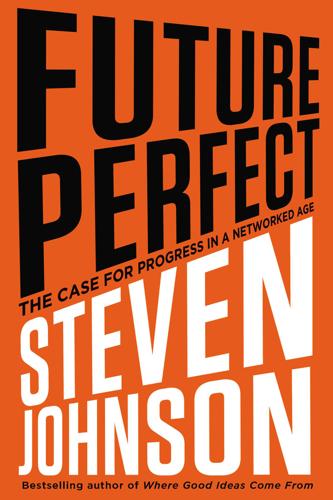
Future Perfect: The Case for Progress in a Networked Age
by
Steven Johnson
Published 14 Jul 2012
Ten million dollars would be awarded to any group that could carry three people beyond the earth’s atmosphere, approximately sixty-two miles above the surface of the planet. (To prove that the solution was a durable one, the prizewinner had to complete the mission successfully twice in two weeks.) Eight years after Diamandis announced the competition, the Ansari X Prize was awarded to the creators of SpaceShipOne, led by aerospace legend Burt Rutan and Microsoft cofounder Paul Allen. Not only did SpaceShipOne break the government monopoly on space travel, it has also helped spur almost $2 billion in public and private funding for the civilian spaceflight industry, just as Lindbergh’s flight helped usher in the age of commercial air travel. Today the X Prize Foundation offers more than $100 million in prize-backed challenges that reward innovation in genomics, personal health care technology, automobile energy efficiency, and oil cleanup.
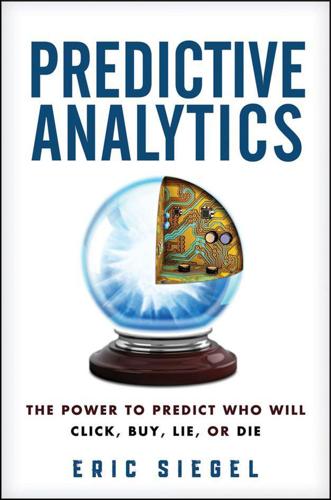
Predictive Analytics: The Power to Predict Who Will Click, Buy, Lie, or Die
by
Eric Siegel
Published 19 Feb 2013
But by night, at home, the two-member team plugged away, for 10 to 20 hours per week apiece, racing ahead in the contest under the team name PragmaticTheory. The “pragmatic” approach proved groundbreaking. The team wavered in and out of the number one slot; during the final months of the competition, the team was often in the top echelons. There emerges an uncanny parallel to SpaceShipOne, the first privately funded human spaceflight, which won the $10 million Ansari X Prize. According to some, this small team, short on resources with a spend of only $25 million, put the established, gargantuan NASA to shame by doing more for so much less. PA competitions do for data science what the X Prize did for rocket science.
…
Michael Liedtke, “Netflix Recommendations Are About to Get Better, Say Execs,” Huffington Post Online, April 9, 2012. www.huffingtonpost.com/2012/04/09/netflix-recommendations_n_1413179.html. Netflix Prize team BellKor’s Pragmatic Chaos: “BellKor’s Pragmatic Chaos Is the Winner of the $1 Million Netflix Prize!!!!” September 17, 2009. www2.research.att.com/~volinsky/netflix/bpc.html. Regarding SpaceShipOne and the XPrize: XPrize Foundation, “Ansari X Prize,” XPrize Foundation, updated April 25, 2012. http://space.xprize.org/ansari-x-prize. Netflix Prize team PragmaticTheory: PragmaticTheory website. https://sites.google.com/site/pragmatictheory/. Netflix Prize team BigChaos: Istvan Pilaszy, “Lessons That We Learned from the Netflix Prize,” Predictive Analytics World Washington, DC, Conference, October 21, 2009, Washington, DC. www.predictiveanalyticsworld.com/dc/2009/agenda.php#day2–13.
…
See PA (predictive analytics) Predictive Analytics World (PAW) conferences predictive models defined marketing models overlearning and assuming response modeling response uplift modeling univariate vs. multivariate See also ensemble models predictive models, launching about action and decision making causality and deployment phase Elder’s success in going live machine learning and building observation and personalization and risks in uplift modeling predictive technology See also machine learning predictor variables pregnancy and birth, predicting customer pregnancy and buying behavior premature births prejudice, risk of PREMIER Bankcard privacy Google policies on insight vs. intrusion regarding predicted consumer data and profiling customers Progressive Insurance psychology emotions, cause and effect of Freud on emotions predictive analysis in schizophrenia, predicting psychopathy, predicting Psych (TV show) purchases, predicting Q Quadstone R Radcliffe, Nicholas Radica Games Ralph’s random forests Rebellion Research recency recidivism prediction for law enforcement recommendation systems Reed Elsevier reliability modeling REO Speedwagon (band) response modeling drawbacks of examples of targeted marketing with response rates response uplift modeling retail websites, behavior on retirement, health and Richmond (VA) Police Department Rio Salado Community College Riskprediction.org.uk risk management risk scores Risky Business (film) Robin, Leo Romney, Mitt Royal Astronomy Society R software Russell, Bertrand Rutter, Brad S Saaf, Randy safety and efficiency, PA for Safeway sales leads, predicting Salford Systems Salsburg, David Santa Cruz (CA) Police Department sarcasm, in reviews Sartre, Jean-Paul SAS satellites, predicting fault in satisficing Schamberg, Lisa schizophrenia, predicting Schlitz, Don Schmidt, Eric Schwartz, Ari Science magazine security levels, predicting self-driving cars Selfridge, Oliver Semisonic (band) sepsis, predicting Sessions, Roger Shakespeare, William Shaw, George Bernard Shearer, Colin shopping habits, predicting sickness, predicting Siegel, Eric silence, concept of Silver, Nate Simpsons, The (TV show) Siri Sisters of Mercy Health Systems small business credit risks Smarr, Larry smoking and smokers health problems and causation for motion disorders and social effect and quitting SNTMNT Sobel, David social computing social effect social media networks data glut on happiness as contagious on healthcare LinkedIn PA for spam filtering on Twitter viral tweets and posts on YouTube See also Facebook sociology, uplift modeling applications for SpaceShipOne spam filtering Spider-Man (film) sporting events, crime rates and sports cars Sprint SPSS staff behavior. See employees and staff Standard & Poor’s (S&P) 500 Stanford University staplers, hiring behavior and Star Trek (TV shows and films) Statistics StatSoft stealing, predicting Steinberg, Dan stock market predictions anxiety and mood predictions for black box trading systems Standard & Poor’s (S&P) 500 Stone, Charles Stop & Shop street crime, predicting student dropout risks, predicting student performance, predicting suicide bombers, life insurance and Sun Microsystems SuperFreakonomics (Levitt and Dubner) supermarket visits, predicting Surowiecki, James Sweden system failures, predicting Szarkowski, John T T.
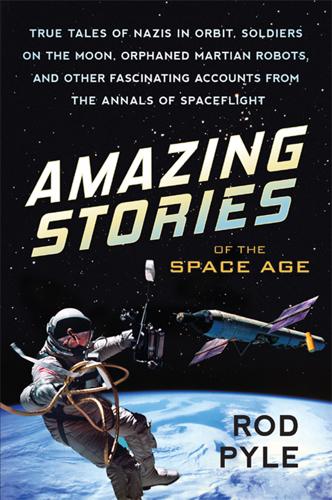
Amazing Stories of the Space Age
by
Rod Pyle
Published 21 Dec 2016
But with increasingly tense relations between Russia and the US, a new first-stage rocket engine design was solicited, and Bezos's company seems to have the job. The new engine, the BE-4, will be used to power ULA's replacement for the Atlas, called the Vulcan. Richard Branson's Virgin Galactic continues on its quest to build the first tourist spaceflight vehicle. Carried aloft for launch by a larger plane in a fashion similar to the X-15, SpaceShipOne, and its updated version, SpaceShipTwo, has been extensively tested. Despite a catastrophic crash in 2014,4 the company continues to develop the spaceplane and expects revenue flights to begin before 2020. At the current time, increased effort is being directed at a satellite delivery system based on similar technology—unpiloted spacecraft have much lower safety requirements, and are viewed by Virgin as a good parallel business.
…
See also Zond project Soyuz 11 crew dying during reentry, 318n1 (chap. 16) US astronauts flying on after 2011, 263–77 weapons available, 263, 264–65 “Space Crawler” in Matt Mason toy line, 292 Space Launch System (mega-booster), 320n1 spaceplanes, 79, 116, 249, 295, 306n11 mini-spaceplanes, 164, 315n1 Russian Spiral program, 285–86 See also Buran; Dyna-Soar, Project; Silverbird, Project; X-15 suborbital rocket plane Space Race, 34, 94, 140, 186, 189, 201, 203 battle to be first on the moon, 185–86, 202 Russian attempt to orbit moon before US landed on it, 201–210 Russian firsts, 186, 189 success of Sputnik program, 25–26, 100, 159, 186–87 US firsts, 122–26, 186, 189, 202 US setback with failure of Vanguard TV-3 rocket, 26 See also military projects in space Space Science Board, 104 SpaceShipOne, 295 SpaceShipTwo, 295 Space Shuttle Main Engines (SSMEs), 251, 253, 261 Space Launch System (mega-booster) using, 320n1 space shuttles comparing US's to USSR's, 281, 282–83 Dyna-Soar as first space shuttle. See Dyna-Soar, Project NASA's space shuttle program, 250, 252–53 Challenger, loss of, 249, 252, 254–55, 257, 258, 259, 259, 286, 315n1 Columbia, loss of, 213, 249, 254, 255–56, 258, 260, 261 costs of, 252, 253 impact of Challenger and Columbia accidents on, 256, 320n3 need for reusable systems, 249–50, 307n3 number of flights, 19, 261 replacing Apollo program with, 280, 293 reusability, 74–75, 249, 250, 307n3 USSR's Buran (space shuttle), 279–89, 281, 284 See also spaceplanes space stations, 81–89, 276 in 2001: A Space Odyssey (movie), 87 China's plans for, 293 in the Matt Mason toy line, 292 NASA studying options for, 30, 138–39, 235 inflatable space station, 81–89, 82 See also International Space Station; Salyut space stations; Skylab space suits, 216–18.
…
See Society for Space Travel Vietnam War, 142, 275 Viking missions, 221–26, 225, 307n15 calling for extreme miniaturization, 224–25 computer for, 224–25, 226 Viking 1 mission, 219 end of the lander, 229–31 landing site, 228 launch of, 226 shutdown of orbiter, 229 Viking 2 mission, 226 landing site, 228 orbiter failure, 229 Virgin Galactic, 216, 293, 295 von Braun, Wernher, 8, 23–24, 51, 58, 107, 158, 186, 299, 305n16 member of Society for Space Travel, 11, 61 and Nova rocket, 56–57 novel written by, 43 work in Germany, 10, 11, 12, 18, 23–24, 92, 170 work in US, 24–25, 34, 50, 94 on Explorer 1 satellite, 26–27 inflatable space station, 81–89, 82, 84 on Project Horizon, 27–34 and Project Orion, 66 Redstone missile project, 25 rehabilitation of image, 86–87 and Saturn rockets, 107, 181, 191, 305n14 work on V-2 ballistic missiles project, 12, 18, 24, 25, 42, 109, 158, 177–78, 304n9 See also Das Marsprojekt [The Mars Project] Voskhod capsule, 187, 201, 204 Voskhod 2, 190 Vostok capsule, 180, 187–89, 201, 204, 317n14 changing design to carry three cosmonauts, 189 use of an ablative heatshield, 212 Voyager missions to the outer planets, 307n15 Voyager program to Mars, 220–21 Vulcan rocket, 295 weapons in space, 263–77, 322n3 Webb, James, 138–39 Weiss, Gus, 289 Weitz, Paul, 239, 241–42, 246 “wet workshop,” 235, 237 Wheel, The (inflatable space station), 81–89 White, Ed, 116–17, 122 Willis, Ed, 107–108 Wonderful World of Disney, The (TV series), 86 World War II, 21 American and Allied freighters torpedoed, 302n17 German scenario for ending by bombing Manhattan, 9–20 psychological impact of on US, 17, 303n17 X-15B (reaching orbit), 169–83, 183 compared to X-15, 177, 179 X-15A-2 closest to an orbital version, 181–82 X-15 suborbital rocket plane, 13–14, 18, 28, 78, 110, 115, 157–58, 159, 162, 170–77 compared to X-15B, 177, 179 different configurations, 174, 176 Engle's flight of, 173–76, 178, 179, 180–81, 182 problems encountered, 175–76 specifications for, 174 standard plan for, 170–73 success of, 183 use of design in the MOL project, 166 Virgin Galactic's SpaceShipOne similar to, 295 X-20 spaceplane. See Dyna-Soar, Project X-37 mini-spaceplane, 315n1 X-planes Bell X-1, 169 X-15A-2, 170, 181–82 See also Dyna-Soar, Project; X-15 suborbital rocket plane Yeager, Chuck, 157, 174–75 Zond project, 205, 206–210 compared to Apollo system, 206 Zond 4, 207 Zond 5, 207–208 capsule design for, 207 carrying plants and animals, 208–209 Zond 6 and 8, 209 Zuckert, Eugene, 133–34

Makers
by
Chris Anderson
Published 1 Oct 2012
The vehicles come in a pair: SpaceShipTwo, a sleek bullet of a spaceplane with a unique tail that pops up to a 45-degree angle on descent to slow the aircraft with a controlled stall after it has taken its passengers to the edge of space, and WhiteKnightTwo, a 747-sized four-engine giant that carries SpaceShipTwo aloft, along with a cabin full of other passengers who will get a zero-G parabolic ride on the way back. Both are descended from SpaceShipOne and WhiteKnightOne, which won Scaled the Ansari X-Prize for the first commercial flight to space in 2004. Like everything else Scaled makes, the spacecraft are constructed almost entirely of fiberglass and carbon fiber. It’s a matter of some irritation to Burt Rutan, who retired in 2011, that the landing gear is still steel and aluminum; they are among the last vestiges of the metal-aircraft era that Scaled was created to end (thus the Composites in its name).
…
As much as Rutan’s roots were in the DIY movement, the economics of developing advanced designs in secret for big companies and government contracts were irresistible. Most of all, Rutan wanted to design groundbreaking aircraft, not feed the endless demands of the kit business. Today Scaled Composites is owned by Northrop Grumman. For every high-profile design like SpaceShipOne, there is a cruise missile prototype or stealthy drone for the defense industry. The DIY roots are still there in all the side projects of the Scaled engineers in their personal hangars along the flight line at the Mojave airport. But the company itself is a high-security operation. Rutan’s career is an object lesson in both the potential and the limits of the Maker Movement.
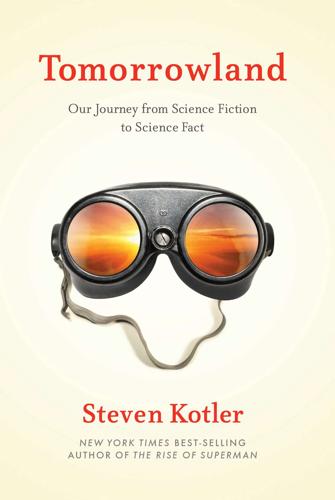
Tomorrowland: Our Journey From Science Fiction to Science Fact
by
Steven Kotler
Published 11 May 2015
In plainer language, experts have said that if the passengers on the space shuttle Challenger had been equipped with Baumgartner’s suit they might have lived through their midair crack up. Along just these lines, some six months after Baumgartner’s jump, Virgin Galactic’s SpaceShipTwo powered up its engines for the first time. SpaceShipOne, you might remember, was the craft that won the Ansari XPRIZE in 2004. This original XPRIZE was a demonstration project, both proof that a private company could produce an affordable, reusable spaceship and the necessary first step in opening the space frontier. The idea behind SpaceShipTwo is the next step: tourism — taking paying customers on suborbital cruises.
…
Wade, 208 Rosenau, William, 233–34 Ross, Ronald, 134 Ross, Stephen, 169 Rossin, Dave, 118 Rothenberg, Ron, 185–87, 192, 197–98 Rothman, Cappy, 247, 249–63 Rothman, Norman “Roughneck,” 249 Rozelle, David, 5–7, 10–12, 15–19, 20–21 Rubin, Gerald, 136–37 Rutan, Burt, 151 Salk, Jonas, 55 Sandoz Pharmaceuticals, 168 Saskatchewan Study, 169 Satava, Richard, 15 Schmidt, Eric, 145 Schwartz, Peter, 11 science fiction on asteroid mining, 145, 147–48 on mind uploading, 27–28 terraforming in, 87 Sears, Derek, 150 Seattle Study, 39–40 self, boundaries of, 46–47 Selfridge, Tom, 66–67 Senate Bill 212, 215 serotonin, 42 Shaw, George Bernard, 3 Shell, 148 Siegel, Ronald, 167 Simak, Paul, 145 Single Mothers by Choice, 253 The Singularity Is Near (Kurzweil), 28 The Six Million Dollar Man (TV show), 11 ski-BASE, 130 Skycar, 100 skydiving, 35–36, 125–30 Skygrabber, 235 slavery, financial profitability of, 51–53 smallpox, 236–37 Small Scale Nuclear Reactors, 119, 121 Socolow, Robert, 114 Solazyme, 231–32 Sorenson, Kirk, 120 Soul Catcher, 25–27, 28, 30–31 sound barrier, xii, 101 Southern Baptist Church, 260 Space Adventures Ltd., 145 SpaceShipOne, 129 SpaceShipTwo, xiii, 129 space travel, 129–30 asteroid mining and, 141–52 ethics of, 143–47 off-world colonies and, 150–51 XPRIZE competition for, xi–xiii, 129 Special Theory of Relativity, 109 SPECT (single positron emission computed topography), 45–46 Spenser, Jack, 111 sperm banks, 247–63 donor anonymity in, 253–57, 260–62 donor screening for, 252–53, 261–62 donor tracking by, 256–57, 262 economics of, 250–51 incest among offspring from, 257–60 regulation of, 251, 258–59, 260–63 Spirit of America (car), xii spiritual traditions, xiv–xvi fear of death and, 29 mystical experiences and, 33–48 near-death experiences and, 42–45 psychedelic drugs in, 167–68 spoonbills, 93–94 sports extreme, 125–30 out-of-body experiences in, 36–37 as play, 125 prosthetics and, 12–13, 15, 17, 19–20 skydiving, 35–36, 125–30 steroid use in, 183, 187–90, 193–95 weightlifting, 189–90 Spradling, Allan, 136, 137 stabilization wedges, 114 Stanford, George, 106, 119–120 Stanford University, 216–17 Stapledon, Olaf, 85 Stardust (space vehicle), 146 starry-night effect, 64–65 stars, creation of, xvii State Children’s Health Insurance Program, 210 Steindl-Rast, David, 173 stem cells, 201–18 anti-abortion war and, 208–10 in anti-aging medicine, 199 availability of for research, 211–13 bioweapons and, 240 cancer and, 205 conflated with cloning, 214–15 defining life and, 209 efforts to change federal law on, 213–15 from embryos, 209 fetal, 208–10 hematopoietic, 205–6 hybridization of, 200 loss of research and researchers on in the US, 212–13 methods for obtaining, 207–8, 214–15 organ transplants and, 204–5 parthenogenesis of, 208 politicization of, 206–17 potential of, 206 state legislation on, 211–13 StemCells Inc., 216 Sterling, Bruce, 247 Steroid Control Act, 189–90, 198 steroids, 183–200 for AIDS treatment, 196–97 anabolic and androgenic, 192 for cosmetic purposes, 190 DHEA, 186, 198 early research on, 192–93 human growth hormone, 198 metabolic effects of, 190–92 misinformation about, 183–84, 188–90, 193–95 negative effects of, 188–89, 194 research on, 189–90 ’roid rage and, 189 in sports, 183, 187–90, 193–95 testosterone, 192–93, 198–99 Stewart, Jon, 145 Stratos Project, 127–30 Strauss, Lewis, 109 Studebaker, winged, 100 Studies in Conflict and Terrorism, 233–34 sugarcane farming, 87–89 Sulgin, Alexander, 160 Survival Research Labs, 101 Svalbard Global Seed Vault, 249 Swiss Federal Institute of Technology, 27 synthetic biology, xv, 219, 230–38, 241–42 Synthetic Genomics, 230 Szilárd, Leó, 109 Talent, Jim, 237 technology criminal use of, 235–36, 246 democratization of, 247–48 disruptive, xiv–xvi, 31, 151 evolution and, 56–59 irresistibility of, xvi–xvii rate of change in, 28, 57, 225–27 technopatric speciation, 58–59 techno-physio evolution, 54–57 telomeres, 191 temporal lobe, 43–45, 47–48 terraforming, 81–95 Terrafugia Transition, 100 Terra Nostra (Fuentes), 23 TerraPower, 121 terrorism, 229–30 bioweapons in, 233–38, 241–42 FBI biosecurity conferences and, 236–37 information technology in, 235 nuclear energy and, 120 testosterone, 192–93, 198–200 theory of mind, 23 This Is Reality (Martensson), 27 This Timeless Moment (Huxley), 181–82 Thompson, Hunter S., 168, 171 thorium reactors, 119–20 Three Mile Island, 110, 118 Thurmond, Strom, 213–14 Time on the Cross: An Economic Analysis of American Negro Slavery (Fogel & Engerman), 52–53 Tito, Dennis, 145 Toshiba, 121 Toth, Lou, 85–86 tourism, space, 129–30 transcendent states, 45–47, 165 trans fats, 198 transposable elements, 136–38 traveling wave reactors, 121 Truax, Robert, 101 Truax Engineering, 101 Tsiolkovsky, Konstantin, 145 Tsukamoto, Ann, 216 “The Tunnel Under the World” (Pohl), 27 tunnel vision, 41–42 UK Royal Commission on Environmental Pollution, 115 United Nations, 217 unity, cosmic, 45–47, 165, 175 US Air Force, 241 US Department of Energy, 119, 228 van Lommel, Pim, 40, 42 Venter, Craig, 228, 230, 231, 247 Vergel, Nelson, 196–97 Virgin Galactic, 129 vision artificial implants for, xiv, xvi, 26, 61–77 cost of artificial, 75–76 effects of electricity on, 79, 80–81 functional mobility in, 67 neuroprosthesis for, 67 religions on, 74 retinal implants for, 66–67 starry-night effect in, 64–65 tunnel, in near-death experiences, 41–42 “The Voice” (Butcher), 37 Walter Reed hospital, 15, 17 Walton, Ernest, 109 water impoundments, 88–90 Waterman, Waldo, 100 Watson (artificial intelligence), 223 weapons of mass destruction, 227, 245–46 Weapons of Mass Destruction Directorate, 236–37 weightlifters, 189–90 Weiland, James, 76–77 Weissman, Irv, 203–7, 209, 211, 215–17 Weldon, Dave, 215 Weldon Bill, 215 West Nile virus, 133, 134 What Technology Wants (Kelly), xvi–xvii Whinnery, James, 40–42 Wick, Douglas, 213–14 Wikileaks, 224, 242 Wimmer, Eckard, 233 Winkler, Allan, 110 World Health Organization (WHO), 61 Wright Brothers, 72–73 XPRIZE, xi–xiii, 129, 141, 151 yellow fever, 133, 137 Yesalis, Charles, 195 You, Edward, 236–37 Yushchenko, Viktor, 238 Zee-Aero, 105 Zucker, Jerry, 213–14

Dogfight: How Apple and Google Went to War and Started a Revolution
by
Fred Vogelstein
Published 12 Nov 2013
Visual signs of its unconventional approach to problem solving remain everywhere. Googlers on red, green, and blue bicycles and motorized scooters zip from building to building. A fifteen-foot-high replica of a T. rex named Stan presides over the main outdoor lunch patio. A few feet away is a replica of SpaceShipOne, Burt Rutan’s first manned private spaceship in 2004. Many lobbies have pianos and vibrating massage chairs; and many restrooms have heated Japanese toilet seats—an odd experience on a hot day when the person before you has forgotten to turn the heater off. Google uses so many solar panels for power that it ranks as one of the largest corporate solar installations in the world.
…
Samsung trial; iPad and; iPhone given to; Jobs and; Open Handset Alliance and; role at Google; on smartphones Sculley, John SEC Seidenberg, Ivan Sense by HTC Sequoia Capital Sewing Machine Combination sewing machines Shazam Shockley, William Sholes, Christopher Latham Showtime Sidekick smartphone Sigman, Stan Silicon Valley; convergence and; entertainment industry and; software copyright law and Silver Lake Capital Singer, Isaac Siri Skype smartphones; Android, see Android phones; apps for, see apps; BlackBerry, see BlackBerry; carriers for, see wireless carriers; Google applications on; Internet and; iPhone, see iPhone; network for; price of; Quattro Wireless and; sales of TVs vs.; Schmidt on; switch from cell phones to; Windows on Snow Fall project social media: Facebook, see Facebook; MySpace; Twitter software: copyright law and; patents on Sony SOPA/PIPA SpaceShipOne Spacey, Kevin Spindler, Michael Spotify spreadsheet programs Sprint Stahl, Norman Stanford University Star7 Stone, Matt Stratton, John Strickon, Josh Stringer, Christopher Summly Sun Microsystems Symbian tablets; EO; GRiDPad; iPad, see iPad; Microsoft; Nexus 7; sales of televisions vs.
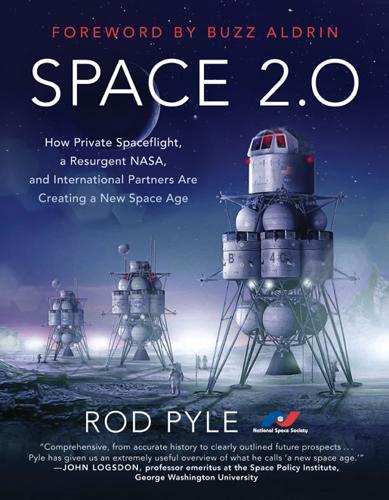
Space 2.0
by
Rod Pyle
Published 2 Jan 2019
Branson has been working on a plan to democratize space tourism since 2004; he has named his newest spacecraft Unity. This modern craft is patterned after a decade of pioneering work by Burt Rutan, the man who built a rocketplane to win the Ansari X Prize. Rutan won the multimillion-dollar cash award in 2004 for flying SpaceShipOne twice in one week to the edge of space. He subsequently merged his efforts with Branson, though Rutan later left the company to pursue other space ventures. But his unique and innovative rocketplane design concepts live on. Entrance to Mojave Spaceport. Image credit: Wikimedia Commons/Californiacondor Virgin’s assembly facility fills a vast modern building amid smaller, older hangars.
…
See also space entrepreneurs Chad Anderson, 155–158 ATK, 152–153 Jeff Bezos, 151, 154 Steve Jurvetson, 155, 158–160, 159 Elon Musk, 154, 158, 159 mutual funds for, 154 NanoRacks, 154, 157 NewSpace, 152 Orbital Sciences, 152, 158 Planetary Resources, 158 Planet Labs, 159, 160, 160 Sea Launch, 153–154 Space Angels, 155, 155–158 Spacehub, 153, 153 Space Services Incorporated, 152, 153, 154 SpaceX, 156–160 Tesla, Inc., 159 Space Launch Complex 4E (SLC-4E), 112 Space Launch System (SLS) Block 1 shuttle, 53 and Blue Origin, 140, 244 defined, 291 Gateway launched by, 242 Orion and, 9, 10, 52, 55, 196, 246, 249 Space Medicine Association, 74 Space Policy Institute, 186–187 Space Poop Challenge, 107 Space Portal, 199 space race. see also new space race defined, 292 and international cooperation, 163–168 in 1960s, 13, 42–44, 69 Space Services Incorporated (SSI), 152, 153, 154 space settlement, 62–65, 233–252, 248 creating incentives for, 250–252 defined, 292 entrepreneurs and, 236 and human survival, 234–236, 238 on Mars, 249–250 on the moon, 62–63, 242–245 NASA and, 237–239, 241–244 non-human, 235 and resource utilization, 234, 235 technology to support, 239–242 timeline for, 245–250 via O’Neill space cylinders, 240–241, 241 Space Settlement Summit (2017), 204, 205 SpaceShipOne, 94 SpaceShipTwo, 98, 99 space shuttle. see US space shuttle Space Studies Institute, 240, 241, 269 space suits, 69–71, 199 Space Symposium, 267 Space Systems/Loral (SSL), 179 Space Tech Summit 2018, 161 space tourism, 59, 101–102, 137, 245, 264 Space Transportation System, 2 space tugs, 145, 146, 148 spacewalks, 70, 71, 184 SpaceX, 111–132, 156–160 Big Falcon Rocket, 86 Jim Cantrell and, 104 Commercial Crew Program funding, 135 as commercial spacecraft, 7, 9–12, 194, 245 and cost of launching water into orbit, 88, 89 and crewed landings, 247 defined, 292 and Dragon rockets, 19, 50, 50, 119, 123, 126, 159, 185, 210 Falcon 9, 215, 215, 255–257 Falcon Heavy, 146 and global broadband internet access, 130–132 headquarters, 121, 121–122, 124 investors of, 129–130 and isogrip machining, 123 landings on Mars by, 249 large rocket development by, 52, 55 late deadlines of, 187 and launch costs, 131 launch sites, 111–113, 112–118, 120–121 in low Earth orbit, xiv Elon Musk and, 115–120, 116 NASA partnership with, 129–130, 140, 174 pilot space settlements by, 248 plans for Mars, 125, 125–126, 129, 244 public support of, 252 and reusability, 39, 119–120, 125, 126–128, 186, 197, 204 rocket factory, 122, 122–124, 126, 159, 256 satellites launched by, 102 Gwynne Shotwell and, 124–126 Tesla roadster, 261 United Launch Alliance vs., 142–145 Virgin Galactic vs., 121 Spudis, Paul, 233 Sputnik, 40, 40, 183, 191 SSI (Space Services Incorporated), 152, 153, 154 SSL (Space Systems/Loral), 179 Stafford, Tom, 166 Stanford Torus, 241 Starbucks, 29 star cluster, 83 Starliner, 11, 12, 50, 50, 55, 185 “Starman,” 260, 261 stars, as source of radiation, 83–84 “Starship.” see Big Falcon Spaceship Star Trek (television), 80, 233 STEAM activities, 266 STEM activities, 266 Stern, Alan, 132 storage depots, 208, 221 storm shelters, 90 Stratolaunch rocket, 102, 245–246 Students for the Exploration and Development of Space (SEDS), 269 Styx, 34 submarines, 76, 76–77 suborbital flight, 245 suits, for astronauts, 69–71 sun, as source of radiation, 83–84 sunset, from space, 16 superconductors, 90 “Super Heavy.” see Big Falcon Rocket survival of humanity, 20–21, 34–36 T “taikonauts,” 192, 193 tankers, 88 Tarver, Bill, 73–76, 78–79, 85 Tau Zero Foundation, 267 temperatures impact of asteroids on, 228 in space, 21, 70 territoriality, 76–77 Tesla, Inc., 159 Tesla roadster, 260, 260–261 Teslar satellite, 211 3-D printers, 106–107, 206, 211, 242–243, 247 3U cubesats, 106 Tiangong space station, 12, 54, 193, 193, 195, 196, 291 tiles, heat-absorbing, 18–19 timeline, for space settlement cislunar Space, 246–248 Earth orbit, 245–246 Mars, 249–250 suborbital fight, 245 TOPEX Poseidon ocean observing system, 169 tourism, in space, 59, 101–102, 137, 245, 264 Trump, Donald, 10, 10, 171, 220–221 Tsiolkovsky, Konstantin, 16 tsunamis, 227 Tumlin, Rick, 218–219 twin boosters, 259 2001: A Space Odyssey (movie), 81 U UAESA (United Arab Emirates Space Agency), 180 Ukraine, 153 ULA. see United Launch Alliance UN (United Nations), 165, 271 United Arab Emirates, 180 United Arab Emirates Space Agency (UAESA), 180 United Launch Alliance (ULA), 119 ACES stage, 145 Advanced Programs, 147 Atlas rockets, 11, 118, 122, 142, 164, 175, 187 Atlas V rocket, 50, 55, 119, 135, 140, 142, 143, 143, 147, 149, 153, 188, 289 Tory Bruno and, 143 CisLunar-1000 Economy, 207, 208, 214–215 Commercial Crew Program funding, 135 defined, 292 Delta IV Heavy, 142, 146 Delta IV rocket, 52, 55, 117–119, 135, 142, 146, 289 Delta rockets, 118, 122 headquarters, 141 in low Earth orbit, xiv NASA partnership with, 140–141 and new space race, 141–148 part purchases from Russia, 140 and reusability, 204 as rival to Blue Origin, 137 rockets of, 55 SpaceX vs., 142–145 Starliner, 50 US Air Force and, 117–119, 119 Vulcan rocket, 135, 137, 142–143, 144, 246 United Nations (UN), 165, 271 Unity spacecraft, 51, 94–97, 95, 100, 100–101, 101, 171 University of Houston, 137 University of Michigan, 137 University of Rochester Medical Center, 86 University of Strathclyde, 230 University of Tokyo, 174 US Air Force as branch of US armed services, 221 Tory Bruno and, 143 Falcon 9 rocket, 133 Stanley Rosen and, 235 SpaceX and, 114–115, 118–119, 130 United Launch Alliance and, 112, 117–119 US Army, 221 USB-C connector, 105, 106 US Coast Guard, 221 US Congress, 25, 195, 264, 265 US Department of Commerce, 29 US Department of Defense, 119 US House of Representatives, 238 US Marines, 221 US Navy, 221 US Space Force, 171, 221 US space shuttle, 16, 46–47, 292 V Van Allen, James, 41 Van Allen belts, 83, 83 Vandenberg Air Force Base, 111, 112–115, 118, 133 van Zyl, Jakob, 34, 198 Vector Space Systems, 104, 104 Venera probes, 183–184 Venus, 20, 21, 177, 183–184, 184 Viking 1 spacecraft, 46, 250 Virgin Galactic, 95–98 in Mojave Airport, 94–95 and Saudi Arabia, 155 SpaceX vs., 121 tourist flights offered by, 59, 245 Unity and, 51, 100, 100–108, 137 Virgin Orbit, 100–102, 101, 245 von Braun, Wernher, 40, 41, 265 Voskhod, 55 Vostok, 55, 184 Vulcan rocket, 135, 137, 142–143, 144, 246, 289 W Washington Post, 238 waste, elimination of human, 70, 107 water, 62–63, 64, 88, 206, 219, 247 weather satellites, 235 weightlessness, 72–75, 73, 80, 86, 292 Weitz, Paul, 72 Western Test Range, 111 White, Ed, 71 White, Frank, 32 WhiteKnightTwo, 96 Whitesides, George T., 97–98, 98, 100–102 windows, in space stations, 77 work shifts, 76 World War II, 76, 176 Wörner, Johann-Dietrich, 173, 242–243 X X-15 rocketplane, 59, 70, 95, 96, 96 XARM (X-Ray Astronomy Recovery Mission), 175 XEUS lunar lander, 208–209 X-Ray Astronomy Recovery Mission (XARM), 175 Y Yonsei University, 170 Young, John, 71 Yucatán Peninsula, 224, 225 Yuri’s Night, 97, 270 Z Zarya module, 171 Zeitlin, Cary, 85 zero-g, 292 Zond spacecraft, 184 Zubrin, Robert, 30–31, 35, 168, 265 ABOUT THE AUTHOR Rod Pyle is a space author, journalist, and historian who has written thirteen books on space history, exploration, and development for major publishers that have been published in seven languages.

Physics of the Future: How Science Will Shape Human Destiny and Our Daily Lives by the Year 2100
by
Michio Kaku
Published 15 Mar 2011
Some entrepreneurs, who criticize the enormous waste and bureaucracy of NASA, think they can drive down the cost of space travel using market forces. Already, Burt Rutan and his investors won the $10 million Ansari X Prize on October 4, 2004, by having launched SpaceShipOne twice within two weeks to just over 62 miles above the earth. SpaceShipOne is the first rocket-powered spacecraft to have successfully completed a privately funded venture into space. Development costs were about $25 million. Microsoft billionaire Paul Allen helped to underwrite the project. Now, with SpaceShipTwo, Rutan expects to begin tests to make commercial spaceflight a reality.
…
Jacobowitz, PC magazine Jay Jaroslav, former scientist at MIT AI Lab Donald Johanson, paleoanthropologist, discoverer of Lucy George Johnson, science journalist, New York Times Tom Jones, former NASA astronaut Steve Kates, astronomer and radio host Jack Kessler, professor of neurology, director of Feinberg Neuroscience Institute, Northwestern University Robert Kirshner, astronomer, Harvard University Kris Koenig, filmmaker and astronomer Lawrence Krauss, Arizona State University, author of The Physics of Star Trek Robert Lawrence Kuhn, filmmaker and philosopher, PBS TV series Closer to Truth Ray Kurzweil, inventor, author of The Age of Spiritual Machines Robert Lanza, biotechnology, Advanced Cell Technology Roger Launius, coauthor of Robots in Space Stan Lee, creator of Marvel Comics and Spider-Man Michael Lemonick, former senior science editor, Time magazine, Climate Central Arthur Lerner-Lam, geologist, volcanist, Columbia University Simon LeVay, author of When Science Goes Wrong John Lewis, astronomer, University of Arizona Alan Lightman, MIT, author of Einstein’s Dreams George Linehan, author of SpaceShipOne Seth Lloyd, MIT, author of Programming the Universe Joseph Lykken, physicist, Fermi National Accelerator Laboratory Pattie Maes, MIT Media Laboratory Robert Mann, author of Forensic Detective Michael Paul Mason, author of Head Cases W. Patrick McCray, author of Keep Watching the Skies! Glenn McGee, author of The Perfect Baby James McLurkin, former scientist at MIT AI Laboratory, Rice University Paul McMillan, director, Spacewatch, University of Arizona Fulvio Melia, professor of physics and astronomy, University of Arizona William Meller, author of Evolution Rx Paul Meltzer, National Institutes of Health Marvin Minsky, MIT, author of The Society of Mind Hans Moravec, research professor at Carnegie Mellon University, author of Robot the late Phillip Morrison, physicist, MIT Richard Muller, astrophysicist, University of California at Berkeley David Nahamoo, formerly with IBM Human Language Technology Christina Neal, volcanist, Alaska Volcano Observatory, U.S.

Chasing New Horizons: Inside the Epic First Mission to Pluto
by
Alan Stern
and
David Grinspoon
Published 2 May 2018
Another CD-ROM with pictures and notes from people on all the various teams who had designed, built, and launched New Horizons. 4. A Florida state quarter, for the state where New Horizons was launched. 5. A Maryland state quarter, for the state where New Horizons was built. 6. A small piece of carbon fiber from SpaceShipOne, which in 2004 became the first privately built piloted spaceship to reach space. 7. A small U.S. flag on the port side of the spacecraft. 8. A second small U.S. flag on the starboard side of the spacecraft. 9. That 1991 U.S. stamp proclaiming, PLUTO NOT YET EXPLORED, something New Horizons audaciously expected to make obsolete in 2015.
…
See Science Definition Team “Send Your Name to Pluto” promotion SHBOT (Safe Haven by Other Trajectory) flyby plans Shoemaker, Eugene Showalter, Mark Slipher, Vesto Sobel, Dava social media Soderblom, Larry Solar System Exploration Division (SSED) Solar System Exploration Subcommittee (SSES) Solar Wind Around Pluto (SWAP) Southwest Research Institute (SwRI) New Horizons’ construction/development by Soviet Union mission collaboration interest by Phobos launch by Sputnik launch by Space Daily space debris hazards Space Research Institute, Moscow SpaceShipOne spacecraft Space Telescope Science Institute, Baltimore, Maryland Spencer, John Kuiper Belt object search by New Horizons’ “hazards campaign” research by on Pluto flyby findings Spielberg, Steven Sputnik mission (Soviet Union) Sputnik Planitia (Pluto glacier) SSES. See Solar System Exploration Subcommittee Staehle, Rob STAR 48 rocket, launch with Star Trek: Enterprise (TV show) Steffl, Andrew Stern, Joel Stern, Leonard Stone, Ed Student Dust Counter (SDC) Styx (band) Styx (Pluto moon) discovery of formation of shape/rotation of SWAP.
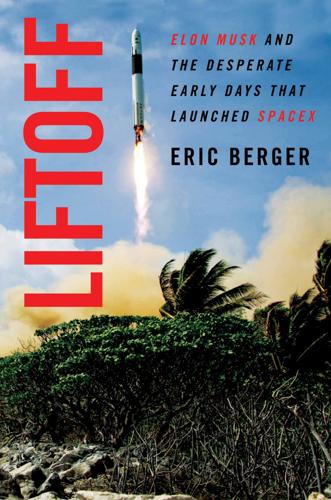
Liftoff: Elon Musk and the Desperate Early Days That Launched SpaceX
by
Eric Berger
Published 2 Mar 2021
Buzza set about establishing a test site where the company could put the Merlin engine through its paces. The Mojave Air and Space Port north of Los Angeles offered facilities for engine testing. No place in the world is really like it, combining an airport, a spaceport, an airplane graveyard, and rocket development warehouses. It was where, in 2004, Scaled Composites’ SpaceShipOne made the first privately funded human spaceflight. In the 2000s, other companies such as XCOR, Masten Space Systems, and Virgin Galactic called the facility home for their development operations. It seemed an ideal location for SpaceX, and initially Buzza reached a deal to use some of XCOR’s property and equipment for tests.
…
See also Omelek site Rotary Rocket, 142 Roth, Ed, 184 Sales, 95–116 Scaled Composites, 39–40 Scorpius, 79–80 Sea Launch, 125, 126 Seal Beach, 53 Searles, Rachel, 21, 22 Sea salt spray and corrosion, 121–23, 233 Sensors, 124, 136 September 11 attacks (2001), 98–99 Sexism, 51, 62 Sheehan, Mike, 185, 190–91, 193, 195–96 Shotwell, Gwynne, 255–56 at Aerospace Corporation, 102 Air Force and, 61–62 background of, 99–101 at Chrysler, 101–2 Falcon 1’s Washington, D.C. debut, 105 Flight One failure, 120 Flight Four launch, 202–3 success, 210–11 hiring of, 95–98 Lockheed Martin and, 112–13 at Microcosm, 50, 95, 96, 102 Omelek site, 54–55 Quake parties, 17–18 sales, 17, 54–55, 96, 97–98, 103–4, 106–7, 112–14, 115, 116, 216, 220 222 Shotwell, Robert, 202–3, 210 Sloan, Chris, 262 Slosh baffles, 127–28, 138, 140 Society of Women Engineers, 100 Solar sails, 10, 164 Soyuz, 93 Space and Missile Defense Command, U.S. Army (USASMDC), 55–57 Space Angels, 113 Space colonization, 12, 217, 232, 244, 256. See also Mars mission Space ethos, 138–39, 236 Space Launch Complex 3 (SLC-3), 52–53, 65 Space policy, 64–65, 145, 169, 220, 229–30, 235 SpaceShipOne, 39–40 Space Shuttle Atlantis, 90 Space Shuttle Challenger disaster, 65, 101 Space Shuttle Columbia disaster, 90, 107 Space Shuttle Discovery, 70–71, 102 SpaceX Dragon. See Dragon SpaceX Kestrel. See Kestrel engine SpaceX Merlin. See Merlin engine Spikes, Branden, 262 Spincraft, 19, 151 Stanford University, 21, 129, 152, 155, 160 Starhopper, 1–2, 4, 265 Starship, 1, 3, 4, 35, 140, 235, 237, 247 Starship Troopers (movie), 168 Star Trek (TV show), 164, 176 Stock options, 15 Strategic Defense Initiative (SDI), 169 Suffredini, Michael, 221 Sunburn, 165–66 Super Heavy Launch System, 247 Supersonic retropropulsion, 233 Survivor (TV show), 75 Swamp Works, 24–25 TacSat, 113–14 Tahiti, 117, 118 Team America: World Police (movie), 93 TEA-TEB, 157–58, 194 Teets, Peter, 103, 104–5 Tesla, 181, 182, 201–2, 216–16, 217, 221, 256 Tesla Model S, 202 Tesla Roadster, 182, 201–2 Texas State Police, 28–29 Texas State Technical College, 45 Thomas, Ed “Eddie,” 77, 119–20, 121, 141, 159, 195, 262 Thompson, Chris, 239–42, 261 Falcon 1, 14–15 Washington, D.C. debut, 106 Flight Three, 177 Flight Four first-stage C-17 transport, 188–89, 191–92 payload, 184 refurbishment after transport, 193, 194–95, 196 founding of SpaceX, 10, 12, 14–18 Li and, 130 Merlin engine, 18–19, 151 Omelek site, 71, 75 everyday life, 166 fact-finding visit, 56–57 first launch attempt, 78–79 Wisconsin trip, 18–19, 151 Thompson, Ryan, 241 Thompson, Taylor, 241 Timeline, 263–65 Titan rockets, 48, 65–66, 224 TiungSAT-1, 54 Tobey, Brett, 236 Trade secrets, 43, 111 Trailblazer, 164 Trump, Donald, 235 TRW Inc., 32, 33–34, 37, 41, 43–44, 161 TR-106 (low-cost pintle engine), 33–34 Turbopumps, 37–38, 40, 92, 248 Turkish goulash, 168, 197, 242 recipe, 267–68 2001: A Space Odyssey (movie), 18 United Launch Alliance, 110–11, 112, 228, 236, 255 University of Bremen, 70 University of Delaware, 129 University of Idaho, 30–31 University of Michigan, 227 University of Southern California, 6, 7, 9, 20 Vance, Ashlee, 216 Vandenberg Air Force Base, 52–53, 64–67 Air Force plans for, 64–65 Falcon 1 static fire test, 47–49, 58–61, 65–66 procurement of site, 50–52 Vietnam War, 62 Virgin Galactic, 40, 241–42, 247 Virgin Orbit, 245 Von Braun, Wernher, 91 Walker, Steven, 98–99, 224 Wertz, James, 50, 79–80 White Sands Missile Range, 79–80 Whitesides, George, 241–42 World War II, 55 XCOR, 39–40 XPRIZE Foundation, 10 Zero-G flight, 141–42 Zurbuchen, Thomas, 227–28 Photo Section (SpaceX) An overview of Omelek, the remote island on the Kwajalein Atoll in the Pacific that became SpaceX’s launch site for the Falcon 1.
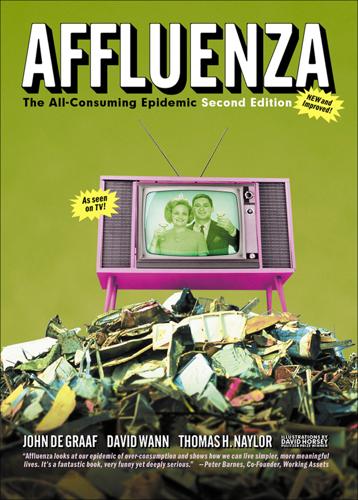
Affluenza: The All-Consuming Epidemic
by
John de Graaf
,
David Wann
,
Thomas H Naylor
and
David Horsey
Published 1 Jan 2001
You might call them Saddam’s revenge. Or Ho-Hummers, if you compare them with yet another way to drop big bucks. In 2001, American Dennis Tito became the world’s first space tourist, for only $20 million. The next year, South African Mark Shuttleworth followed, for the same price.6 In June 2004 SpaceShipOne took off on its first flight, rising sixty-two miles above Earth and entering officially into space.7 Soon, seats will be available for as little as $100,000. If that sounds like a deal, you might want to stick a thermometer in your mouth right away. Ten. . . nine. . . eight. . . . LET’S DO LUNCH We’ve talked about houses and cars.
…
See fulfillment Selling Out American’s Children (Walsh), 56 ShareSaveSpend, 219–20 Shi, David, 131, 133, 141, 152 shopping as addiction, xii–xiii, 14–15, 39, 109–13 birth of department stores, 141 cyber, 16–17 Electronic Mall Madness (game), 55 home, 16 malls, 13–16, 149–50 overwhelming choices and, 42, 49 responsibly, 198–200 retail chains and, 66–68 as therapy, xviii–xix, 17, 49 time stress and, 41–42 Simon, Scott, ix–x, 14–15, 17, 28, 155 Simple Life (Shi), 141, 131 Simpler Living, Compassionate Life (Schut), 185 simplicity downshifters, 181, 185 late nineteenth century, 141 policy and, 199–200 and right livelihood, 178 sustainability and, 245 voluntary simplicity movement, xi, 183–87, 232 Simplicity Forum, xi, 225 Sitting Bull (Tatanka Yotanka), 132 Sobel, David, 192 social class “classless” society, 85 in colonial American, 133–34 expectations and, 29 harried leisure class, 41–42 haves and have-nots, xviii, 81–85 See also economics social norms clutter as, 36–37 giving and, 62 isolation, 65–66, 68–71 market values, 57–58, 159 postwar economic growth, 152 shopping therapy, xviii–xix, 17, 49 throw-away society, 49–50 social status cars and, 26–27 conspicuous consumption and, xii, 25, 86 housing and, 25 “keeping up with the Jones,” xii, 29–30, 78, 158, 173–74 socialism, 136–37, 138 Sony Ericsson, 162 space clutter, 35–36 SpaceShipOne, 27 Sparagon, Bart, 45 “spaving,” 17 spiritual crisis. See discontent; fulfillment standard of living children’s well being, 61–62 decline in, 29–30 GPI and, 7, 239–41 income equality and, 82 overwork and, 42–43, 223–25 personal time and, 39–41, 43–45, 225–27 policy and, 231–33 sustainability and, 245–47 Stanton, Glenn, 50–52 Stauber, John, 161, 162, 164 Steingraber, Sandra, 102 Strasses, Susan, 148 stress busyness and, 39–41 choice and, 42, 247 meaningful work and, 76 overwork and, 42–46, 227 possession overload and, 39 shopping and, 41–42 symptoms of, 38–39 Type A personality and, 45–46 study circles/groups, 183–85, 187 stuff, 32–37 Stuff (Durning and Ryan), 95–96 Super Mall, 13–14 sustainability benefits of, 246–47 community, 237–39 corporations, 186 and the environment, 237, 245 infrastructure for, 222 national, 232–33, 239–41 nature and, 243–44 practices in Europe, 232–33 trends towards, 174, 243, 245 values and, ix–x voluntary simplicity and, xi, 183–87, 232 Sustainable Seattle, 237–39 SUVs, xii, 26–27, 200–201 Swenson, Richard, 38–39, 132 symptoms addiction, xii–xiii, 14–15, 39, 109–13 bankruptcies, 20–21, 22 clutter, 32–37 credit cards, 19–20 crime, 58, 69–70, 76, 86–87 debt, 18–21 education commercialization, 59–61, 231 financial security, 21–22 industrial toxicity, 101–7 isolation, 64–66, 68–71, 206–7 list of, 5 shopping fever, 13–17 See also discontent; expectations; stress T Take Back Your Time, 7, 225–27 taxes, 213, 229–31 Taylor, Betsy, 244–46 technology conspicuous consumption and, 16–17, 28, 34, 37 Internet, 16–17, 121–22, 157, 165, 219–20 time stress and, 40–41 television, 29, 150, 154–55, 216–19, 231 Terkel, Studs, 77–78 Thoreau, Henry David, 137–38 throw-away society, 49–50 time famine, 39–41 Time to Care legislative agenda, 225–26 Toxic Sludge Is Good for You (Stauber), 161 Toynbee, Arnold, 187 transcendentalism, 137–38 travel, 27, 28–29, 35 treatment Adbusters, 215–19 Affluenza Self-Diagnosis Test, 174–76 civic life, 207–9 co-hosing, 209–12 corporate responsibility, 202–3, 230 downshifting, 181, 185–86 Fever Index, 235 financial integrity, 180–81 free time, 225–27 and hope, 243 lifestyle change, 119, 178–80, 197–99 media literacy, 219–20 responsible wealth, 213 smart product design, 202–4 theories on, 6–7 voluntary simplicity, 183–87 work reduction, 223–24, 227, 228 See also nature; personal choice; policy; sustainability Trends 2000 (Celente), 6 Truman, Harry, 151 Turbo-Capitalism (Luttwak), 52 Type A personality, 45–46 U United Kingdom, 231–32 United Methodist Church, 185 V values advertising and, 157, 159 children’s shifting, 61–62 erosion of, 127 family, 47–48, 50–53 identifying and aligning with, 208, 236 international consumer, 87 market created, 50–52, 55–58 meaningful activity/work, 73–76 patience, 41, 43 personal time, 39–41, 43–45 shopping addict’s, 13, 14, 15 subsidized education and, 59–61 sustainability, ix-x See also fulfillment; simplicity Vancouver (British Columbia), 215, 218 Vancouver Island’s West Coast Trail, 91–92 Vermont, 222 voluntary simplicity, xi, 183–87, 232 Voluntary Simplicity (Elgin), 183, 187 W Wachtel, Paul, 24 Wacker, LaNita, 24–25 Wackernagel, Mathis, 96–97, 241 Walden (Thoreau), 137 Wal-Mart, 66, 67 Walsh, David, 56 Wann, Colin, 91–92, 193 Weil, Andrew, 121 What If Boomers Can’t Retire?
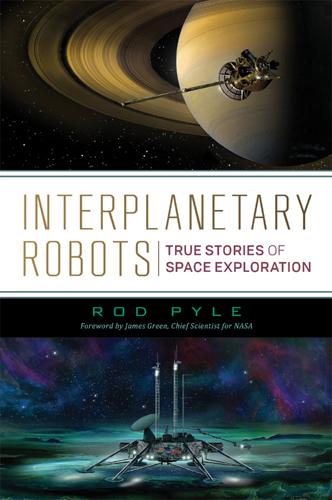
Interplanetary Robots
by
Rod Pyle
This original XPRIZE was announced in 1996 with a cash award of $10 million for the first nongovernmental organization to fly a reusable crewed spacecraft into space (which officially starts at an altitude of 62 miles) twice within two weeks. Aerospace entrepreneur Burt Rutan won this in 2004 with his SpaceShipOne, financed by billionaire Paul Allen. With this successful project behind them, the XPRIZE Foundation partnered with Google to offer the GLXP with underwriting from Google. This time the purse totaled $30 million in various awards, and the challenge was for a privately funded nongovernmental team to fly a robotic machine to the moon, travel 500 meters (about 546 yards), and transmit hi-resolution imagery back to Earth.
…
See Sputnik mission (1957) Soviet Union European Space Agency (ESA) and, 279 exploration of Venus, 147, 148–49 Luna probes, 43–48, 83–84 Lunokhod program, 89–92, 90, 91 manned flights dominated by, 43 Mars program, 225–33 putting spacecraft into Martian orbit, 30 space race, 31, 34–35 US heist of Luna probe of, 48–49 Venera landers, 148–49, 150, 151–54, 152, 163 See also Russia / Russian Federation; Sputnik mission (1957) Soyuz, 163 Space.com, 22 spacecraft designs for traveling to other planetary systems, 218 Longshot, 221–23 spiral-like, curving trajectory for planetary flyby, 171 sterilization of, 54, 113, 263, 307–308, 309 for Venus/Mars flyby, 159–60 See also individual names of spacecraft and missions space exploration, 12 errors within research on, 13 future plans for, 317–24 knowledge gained by, 9 private sector's involvement in, 93–95, 325 US military schemes, 31 Space IL (Israel), 94 Space Launch System (SLS), 61, 62, 319 space race Explorer 1 satellite, 43 Jet Propulsion Laboratory (JPL) and, 106 Luna probes, 43–48, 57 Lunokhod program and, 89 NASA budget cuts and, 173 Pioneer missions, 49–50 Project A119 study, 31–34 Russia's efforts, 34–35, 36 Soviet manned flights, 43 Sputnik missions (1957), 42–43 Surveyor program, 84 US intelligence gathering on Soviet Luna probes, 48–49 Venus and, 148 SpaceShipOne, 93 SpaceX, 29, 95, 105, 144–45, 325 spectrometer, 63, 91, 282, 318, 321. See also mass spectrometer Spilker, Linda, 278, 279, 290, 296 Spirit (Mars Exploration Rover) lander, 97, 303 Sputnik mission (1957), 36, 39, 42 impact of, 9 schematic view of, 40 space race and, 42–43, 106 Sputnik 1 (October 1957), 42 Sputnik 2 (November 1957), 42 Stanford University, 79 STAR (computer), 184 stars, interstellar missions exploring nearby, 217–20 star trackers, 187, 229 static electricity, Voyager and, 187–88 Steltzner, Adam, 272 sterilization of samples, 231 of spacecraft, 54, 113, 263, 307–308, 309 Stone, Ed, 176, 188–89, 189, 194, 196, 197, 199, 202, 211–12 Strategic Defense Initiative (Star Wars), 221 “Study of Lunar Research Flights, A.”
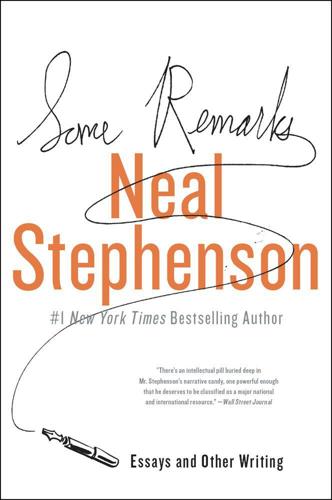
Some Remarks
by
Neal Stephenson
Published 6 Aug 2012
What is it that you do for them and has the recent winning of the X-Prize by the SpaceshipOne team had any effect on Blue Origin’s plans? What are your visions of future private space flight? NEAL: Like Spock on the deck of the Enterprise, I sit in the corner and await opportunities to jump out and yammer about Science. Unlike Spock, I don’t have anyone reporting to me and I never get to sit in the captain’s chair and aim the phasers. This is probably good. Though the X-Prize is cool and good, Blue Origin never intended to compete for it. Consequently, it has had no effect, other than destroying productivity whenever a SpaceShipOne flight is being broadcast.
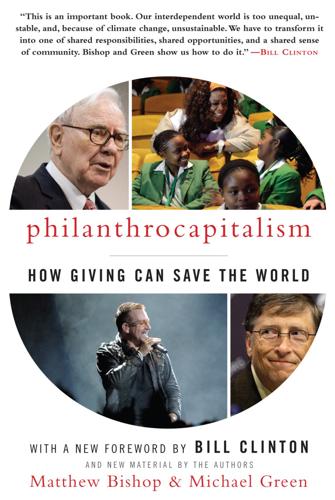
Philanthrocapitalism
by
Matthew Bishop
,
Michael Green
and
Bill Clinton
Published 29 Sep 2008
The race to win a £20,000 prize offered by the British Parliament in the eighteenth century for a solution to how to measure longitude, and the struggle of clockmaker John Harrison to convince the government-appointed panel that he had won, is described in Dava Sobel’s 1995 bestseller, Longitude. Charles Lindbergh flew the Atlantic in 1927 to win a $25,000 prize offered by Raymond Orteig, a hotelier. Now they are back in fashion. The breakthrough moment came when SpaceShipOne won the $10 million X Prize, created by Peter Diamandis, for the first privately funded space flight. In October 2006, the X Prize Foundation launched its second prize, for genomics: $10 million to the first inventor able to sequence a hundred human genomes in ten days. In March 2007 it launched another $10 million prize, for designing “super-efficient cars that people want to buy.”
…
These include the World Economic Forum in Davos, the Clinton Global Initiative, and Technology, Entertainment, and Design (TED), a conference at which luminaries such as Bill Clinton and Bono are awarded prizes to help them achieve a “wish to change the world.” At Davos in 2006, where Google made headlines mostly for the superior quality of the wine served at its party, Page gave a talk about space flight, one of his great passions. Indeed, in the main building of the Googleplex hangs a replica of SpaceShipOne, the privately developed spacecraft that won the first prize—of $10 million—ever awarded by the X Prize Foundation. In Davos in 2007, both Google guys spoke in favor of offsetting carbon emissions in order to combat climate change. They certainly take steps to “offset” the carbon emitted during flights of the Google corporate jet, which was the subject of a rare dispute between the two tycoons, who had a falling out about the size of the beds to be fitted on the Boeing 767.
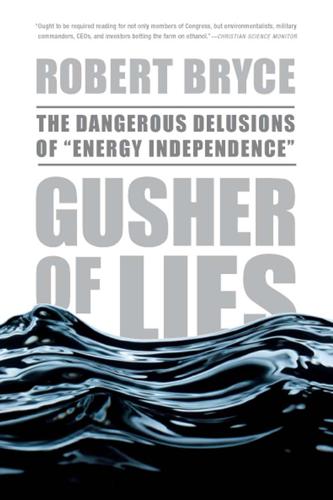
Gusher of Lies: The Dangerous Delusions of Energy Independence
by
Robert Bryce
Published 16 Mar 2011
Eight years later, a previously unknown American named Charles Lindbergh collected that prize.67 More recently, aviation whiz Burt Rutan, backed by billionaire Paul Allen, collected the $10-million Ansari X Prize, which was offered to the first privately built vehicle that could fly to the edge of space, return to earth, and repeat the feat within two weeks. In 2004, their creation, SpaceShipOne, made two trips into low-earth orbit, and Rutan and Allen claimed the $10-million prize. In doing so, they ushered in an era of privately financed spaceflight.68 In early 2007, British billionaire Richard Branson offered a prize (called the Virgin Earth Challenge) that relates directly to energy usage and carbon dioxide emissions: He offered $25 million to anyone who could invent a technology that would remove 1 billion tons of carbon dioxide per year from the atmosphere.69 And while Branson’s prize is laudable, a better solution would be one that prevents the release of carbon dioxide.
…
Mark Shaffer, “Algae Could Be Fuel of the Future,” Arizona Republic, October 14, 2006. Available: http://www.azcentral.com/arizonarepublic/business/ articles/1014biz-algae1014.html. 65. Paul Israel, Edison, 410–421. 66. Credit to Vaclav Smil for first suggesting this idea. 67. http://www.charleslindbergh.com/plane/orteig.asp. 68. Leonard David, “SpaceShipOne Wins $10 Million Ansari X Prize in Historic 2nd Trip to Space,” Space.com, October 4, 2004. Available: http://www .space.com/missionlaunches/xprize2_success_041004.html. 69. John Tierney, “A Cool $25 Million for a Climate Backup Plan,” New York Times, February 13, 2007. Available: http://www.nytimes.com/2007/02/13/ science/earth/13tier.html?

Smart Cities: Big Data, Civic Hackers, and the Quest for a New Utopia
by
Anthony M. Townsend
Published 29 Sep 2013
The Ansari X PRIZE, the granddaddy of modern innovation contests, challenged competitors to build a reusable spacecraft that could fly twice in one week, an unheard-of feat. By defining a single difficult problem, it captured the imagination of the nation’s brightest engineers and most ambitious entrepreneurs, leveraging $100 million in privately funded research with just $10 million in prize money. Less than eight years later, Burt Rutan’s SpaceShipOne touched down in the Mojave Desert to win the purse. The money mattered, but the prestige and breadth of accomplishment were the real motivators. Subsequent rounds of the apps contests in Washington (in 2009) and New York (in 2012) did add a problem-definition round, challenging a larger group of citizens to tell developers the kind of apps they wanted.
…
R., 63 Smithsonian Magazine, 50 Snow, John, 189 social networks: cities as hubs for, 5, 159–64, 304 early days of, 123–25, 234 predictive recommendations for, 152 Songdo, South Korea, 23–31 International Business District in, 23 as largest private real-estate in history, 25 plans for TelePresence in, 49 as world’s largest experiment in urban automation, 24 Songdo U.Life, 49 Sony, 26 PlayStation Network of, 274 Portapak of, 115 Sopwith Camel, 21 Sorkin, Michael, on Archigram, 21 South by Southwest Interactive festival, 146 South Korea: broadband connectivity in, 26 tallest building in, 27 technological innovation in, 23–30 as world leader in smart-city technology, 26 SpaceShipOne, 203 Spain, 217–23 “15–M” movement in, 217 Sprint, 122 Square, 28 Standage, Tom, 44 Stanford University, 44 Starbucks, technological innovation at, 28 Steal This Book (Hoffman), 227 steam power, 5 Steenson, Molly, 21 Stockholm, 244 Stoller, Max, 150 Stoney, George, 116 Street, John, 194–95 Strickland, Eliza, 49 Strowger, Almon B., 36 structural design, innovations in, 19–30 Stuxnet, 266–69 suburbia, 101, 143 Sunlight Foundation, 238 supply-chain management, 77 surveillance, 270–76 private systems of, 275 Surveillance Camera Players, protest theater of, 13 Switzerland, 87 Symantec, 268 systems analysis: dynamics techniques in, 77, 81, 86 engineering in, 77 urban modelling in, 84–86, 88–90 Tabulating Machine Company, 61–62 Tallinn, 245 Taylor, Robert, 260 TCP (Transmission Protocol), 266 TCP/IP, 110 Teach for America, 238 TechCrunch, 151 technology: city-funded projects for, 243 disasters of, 256–58 innovation in, 107–10 overstandardization of, 249–51 repurposing of, 119–20 scaling of, 165, 201, 232, 243, 249, 313–14 as a tool of empowerment, 117–20 technology industry: limited urban understanding of, 224, 247–48 rhetoric of, 107, 278, 288, 317 “walled gardens” of, 123 TED (Technology, Entertainment, Design), 67 Tel Aviv, 233 telecom bubble, 44 Telecom Italia, 137, 161 telecommunications industry, 109–11 obstruction by, 197–98 telecommuting, 6 telegraph: city administration changed through, 5 as first urban digital communication network, 42 as fourth utility, 44 history of, 42–44, 254 industrial management changed through, 5 police use of, 5 in railroad operations, 5 Telegraphen-Bauanstalt von Siemens & Halske, 38 telemetry, 150 telephone: early history of, 5 evolution since 1970s of, 35–37 historical role in social networks, 160–61 TelePresence videoconferencing systems, 46, 49 Teoría General de la Urbanización (General Theory of Urbanization) (Cerdà), 43–44 terrorism, 270–71 Tesla, Nicola, 56 Thinking About the Unthinkable (Kahn), 277 Thomas, Martyn, 265 Tidepools, 293 Tivadar, Puskás, 254 Tokyo, Shibuya Crossing at, 34–35 Tolva, John, 64–65, 208–11, 294 To-Morrow: A Peaceful Path to Real Reform (Howard), 94 “topsight,” 70, 72, 87 Torrone, Phillip, 137–39 Total Information Awareness (TIA), 270–72 Toughbook, 127 traffic engineers, 100–101 traffic jams: impact on cities, 99–103 prediction of, 7 Trendnet, 275 Triumph of the City (Glaeser), 160 Turner, Ted, 116 Twitter, 135, 151, 154–55, 240 in Arab Spring, 12 in Moldovan “Revolution,” 169, 171 in Spain’s anti-austerity protests, 161–62, 218 Uber, 232 ubicomp (ubiquitous computing), 113 “u-chip,” 23 “u-cities,” 26 Ullman, Ellen, 256 uncertainty principle, 88 Union Square Ventures, 154 United Nations: in declaration on Internet access, 288 demographic predictions of, 1–2 Foundation of, 278 Global Pulse project of, 181–84, 191 Millennium Development Goals of, 175 Sustainable Buildings and Climate Initiative at, 163 University College (London), 85 urban dynamics, 82–83, 89 Urban Dynamics (Forrester), 76–78, 82, 86 urban expressways, 101–2 “urban informatics,” systems to process signals as, 32 “urban information architecture,” management and business of, 32 urbanism, sustainable, 83 urbanization: digital technology intersection with, 4 problems of, 8, 162 Urban Land Institute, 30 urban planning, 77–92, 311–16 with computer modelling, 81, 295–98 cybernetics in, 84 “data enthusiasm” in, 315 grassroots organizing in, 8–9, 102–5, 235 impact of cars in, 98–106 innovative potential of, 9–11, 305–6 lattice vs.
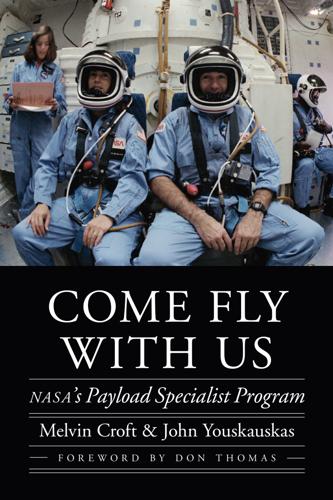
Come Fly With Us: NASA's Payload Specialist Program
by
Melvin Croft
,
John Youskauskas
and
Don Thomas
Published 1 Feb 2019
Virgin Galactic, owned by British entrepreneur Sir Richard Branson, partnered with Burt Rutan’s Scaled Composites and the Spaceship Company of Mojave, California, to produce SpaceShipTwo. In 2004 Rutan and his team claimed the $10 million Ansari X-Prize, after successfully launching the prototype SpaceShipOne three times above the 328,000-foot mark utilizing an air-dropped, rocket-powered, composite-hulled airplane. The design featured a unique feathering mechanism of the twin-boomed tail that allowed a relatively benign, hands-off reentry into the atmosphere, with minimal frictional heating. Blue Origin operated largely in secret for several years before publicly revealing the unmanned test flights of its New Shepard capsule design, which to date has been flown successfully six times and recovered under three main parachutes, much like the Apollo spacecraft.
…
See also Astro-1 Spacelab 1, 391; communications with, 66; components of, 67; crew of, 56; mission specialists and, 10, 17; NASA astronauts and, 29; payload specialists and, 18–19, 30, 60–63, 64–65; planning for, 24; preparations for, 63; problems with, 177; research aboard, 55–56, 68–70, 71–72, 78–79; training for, 24 Spacelab 2, 391; components of, 5, 125–26, 130–31, 133; payload specialists and, 122–24, 136; purposes of, 129; research aboard, 123, 126, 134–35; timing of, 105; training for, 126–27 Spacelab 3, 391; communications with, 113; crew of, 106–7; research aboard, 105–6, 107, 108, 112–13, 118; timing of, 105 The Spacelab Accomplishments Forum, 68, 74, 79 Spacelab: An International Success Story (Lord), 11–12, 15–16 Spacelab D1, 64, 80, 139–40, 391 Spacelab: Research in Earth Orbit (Shapland and Rycroft), 61 space launch complexes (SLCs), 35, 202, 204, 206, 215. See also JSC (Johnson Space Center); MSFC (Marshall Space Flight Center); Vandenberg Air Force Base Spaceman (Massimino), 41, 43–44 Space News Roundup, 86 Space Processing and Applications Rockets (SPAR), 110 Spaceship Company, 386 SpaceShipOne, 386 SpaceShipTwo, 386–87 Space Shuttle (Reichhardt), 116 The Space Station (Mark), 13, 243 space tourists, 386 Space Transportation System, 1, 166, 187 Space Vision System, 93 space walks. See EVA (extravehicular activity) SpaceX, 386, 388 SPAR (Space Processing and Applications Rockets), 110 SPAR Aerospace, 85 Spartan satellites, 259, 353, 374 spatial orientation, human, 71–73 SPO (system program office), 166–67, 194, 199, 203 Sponable, Jess M., 195 Spring, Sherwood “Woody,” 284, 285, 290, 293, 295–97 Springer, Robert, 187 Sputnik, 315 SRBs (solid rocket boosters): aborts and, 362; description of, 7, 183, 257, 326; design changes to, 360, 361; problems with, 119, 183–84, 205, 322, 356, 357–59; and safeguards, 233; at Vandenberg Air Force Base, 204, 206 STA (Shuttle Training Aircraft), 92, 127, 145, 190, 246 Stafford, Tom, 241 Staib, David P., Jr., 200 Starlab, 372 Steimle, Hans-Ulrich, 138–39 Stevens, Theresa M., 200 Stevens, William K., 22 Stevenson, Robert, 87–90, 103, 370 Stewart, Bob, 207, 209 Stone, Randy, 235–36, 248 stored-fluid management demonstration, 188–89 Strategic Defense Initiative, 180, 201, 215, 372 STS-1, 48, 315, 361 STS-4, 1, 55, 229 STS-6, 66 STS-7, 84, 89, 229 STS-8, 66, 89, 229 STS-9, 10, 24, 49, 55–56, 66, 69, 139, 391 STS-10, 177 STS-15, 175 STS-16, 175 STS-17, 89 STS-26, 361 STS-28, 216 STS-31, 49 STS-35, 52, 154, 370 STS-41B, 207 STS-41C, 84 STS-41D, 49, 50–51, 225, 226, 227, 246, 391 STS-41G, 42, 49, 84, 89, 103, 362, 391 STS-42, 80 STS-44, 102, 370, 372 STS-45, 49, 80, 80 STS-50, 119 STS-51A, 345 STS-51B, 105, 106, 119, 139, 391 STS-51C, 139, 177–78, 180, 184, 358, 391 STS-51D, 131, 239, 240, 245, 247, 254, 258, 280, 299, 345, 359, 391 STS-51E, 258, 265 STS-51F, 5, 122, 131, 132, 133, 136, 174, 391 STS-51G, 139, 258, 259, 265, 273, 275, 283, 361, 391 STS-51H, 59 STS-51I, 346 STS-51J, 203–4, 206, 391 STS-51L, 119, 154, 316, 352, 353, 359, 361, 362, 391 STS-52, 101 STS-61A, 80, 137, 139, 177, 391 STS-61B, 283–84, 304, 321, 391 STS-61C, 359, 391 STS-61E, 369 STS-62A, 339, 360, 364, 369 STS-77, 102 STS-86, 265, 274 STS-95, 239, 374, 376 STS-97, 102 STS-107, 175, 376, 378–79, 381 STS-118, 381, 383 STS-135, 221 Sudarmono, Pratiwi, 370 Sullivan, Kathryn: as mission specialist, 84, 89–90, 98–100; on payload specialists, 42, 48, 49–50, 53, 91, 100 Summer Olympics (1984), 262 Sunday Morning Massacre, 199 Sundberg, Eric, 171, 219; applying for astronaut position, 163, 164, 165; background of, 162–63; Jack Fischer and, 218; as MSE, 175, 200, 222; post-astronaut career of, 217–18; on risks, 364; as scuba diver, 198; taking rocket engine, 193–94; on training, 166 sunglint, 92, 99 SUSIM (Solar Ultraviolet Spectral Irradiance Monitor), 126, 136 Syncom satellites, 235, 247, 250, 343, 345 syringes, 294 system program office (SPO), 166–67, 194, 199, 203 T-38, 39, 44–45, 92, 232, 284, 319, 341 TAL (transatlantic abort landing), 7–8 TDRS (tracking and data relay satellites), 66, 98, 176–77, 353 Teacher in Space Program, 243, 314, 350, 353, 369, 374–75, 391 teachers, 341, 347–48, 357, 369, 374–75, 381, 383, 385, 387 Teal Ruby satellite, 202–3 Telesat 1 (Anik C-1), 247, 248 telescopes, 8, 122, 126, 127, 130–31, 133, 134, 370 Telstar satellites, 106, 235, 259 Terra Geode program, 372 Terra Scout program, 370, 372 Terra View program, 372 Terrile, Richard J., 63 Thagard, Norm, 89, 106, 114 Thiokol, 358, 359, 360, 361 Thirkettle, Allan, 74 Thirsk, Robert, 85, 101 Thompson, William D., 195 Thornton, Bill, 13, 23, 62–63, 89, 106, 112, 113–14 thrusters, 100, 111, 272 tire problems, 213, 299, 359, 381 TIROS 1, 308 Titan 34-D, 214–15 toileting, 15, 47, 115, 211, 297–98 tracking and data relay satellites (TDRS), 66, 98, 176–77, 353 training for mission specialists, 63–64, 143–45 training for MSEs, 166–67, 170, 172, 198–99 training for NASA astronauts, 43–45 training for payload specialists: about failure, 366; international, 267; JSC and, 18, 19–21, 22–23, 27–28, 29; mission specialists and, 17, 144–45; MSFC and, 24; NASA astronauts and, 39–40, 41, 44–45, 90, 177–78, 313–14, 319–20; NASA policy and, 64; national security and, 179; by Paul Scully-Power, 91–92; payload sponsors and, 19, 22; plans for, 13, 14–16; by Rodolfo Neri Vela, 284–85.

Immortality, Inc.
by
Chip Walter
Published 7 Jan 2020
Space exploration was his personal fascination going back to his childhood, and in the 1990s, after a series of grand entrepreneurial efforts, he finally landed a fitting project when he created his first XPRIZE. It offered $10 million to any company that could privately build and fly a ship carrying three people into space twice within two weeks. It took eight years, but finally, in 2004, SpaceShipOne took the prize. More importantly, it launched a whole series of XPRIZEs that soon came to influence people up and down the Peninsula, from Larry Page to Elon Musk. These days Diamandis’s XPRIZE projects are designed to drive the invention of just about everything from lunar landings to the elimination of poverty.
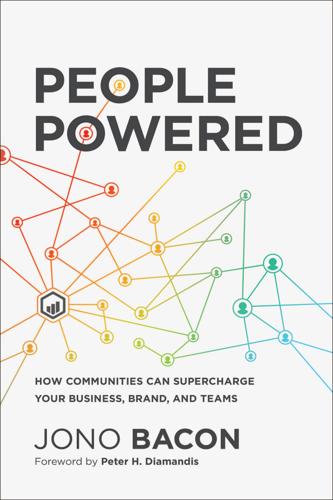
People Powered: How Communities Can Supercharge Your Business, Brand, and Teams
by
Jono Bacon
Published 12 Nov 2019
Just like the Orteig prize, when the XPRIZE was announced, the idea of a private team building and flying human-carrying spaceships looked like an impossible feat. Eight years later, on October 4, 2004, the $10 million Ansari XPRIZE for spaceflight was won by Scaled Composites and their winning vehicle, Space-ShipOne, an event that would fuel a new age of commercial space travel. While these were two different incentive prizes in two different eras, there was one clear pattern running through both: the right mixture of opportunity, potential, and a grit to succeed created a combination able to produce exponential innovation and results.

Exponential Organizations: Why New Organizations Are Ten Times Better, Faster, and Cheaper Than Yours (And What to Do About It)
by
Salim Ismail
and
Yuri van Geest
Published 17 Oct 2014
For Peter Diamandis, it all started with the Ansari X Prize, which rewarded $10 million to the first non-government organization to launch a reusable manned spacecraft into space twice within two weeks. Twenty-six teams from around the world participated, and contestants included everyone from hobbyists to large-corporation-backed teams. In November 2004, Mojave Aerospace Ventures won the prize with its SpaceShipOne spacecraft. Virgin Galactic is currently using the successors to this design to enable commercial space flight, which will cost $250,000 a ticket and is planned for the end of 2014. After the success of the Ansari X Prize, more X Prizes were created. One of X Prize’s current offerings is the Qualcomm Tricorder X Prize, which will award $10 million to the first team whose handheld medical diagnostic device outperforms ten board-certified physicians.
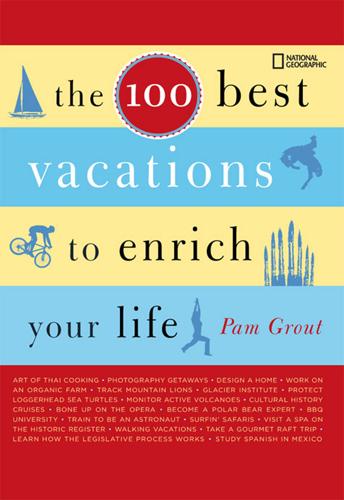
The 100 Best Vacations to Enrich Your Life
by
Pam Grout
Published 14 May 2007
Although you have to be a member of the Smithsonian (something that’s easily taken care of with a $36 donation) and the trips don’t come cheap (a recent trip to India rang in at $15,000), participants in Smithsonian Journeys gain access to the museum’s sizable network of scholars, private dig sites, preservation labs, and other normally off-limits places. There are examples to taking trips from educational institutions. Your average tour operator, for example, could never show you the inside of SpaceShipOne, the first privately financed space plane, or get astrophysicists and astronauts as tour leaders like the American Museum of Natural History did on its recent “Earth Orbit 2006: Inside the U.S. and Russian Space Programs.” Price for that two-continent trip? A mere $37,900 per person. * * * All Smithsonian Journeys are led by study leaders, fascinating experts in various fields of study, and the opera tours are no exception.

The Rise of Superman: Decoding the Science of Ultimate Human Performance
by
Steven Kotler
Published 4 Mar 2014
To put this in plainer language, experts have said that if the passengers on the space shuttle Challenger had been equipped with Baumgartner’s suit, they might have lived through their midair crack-up. And along just these lines, some six months after Baumgartner’s jump, Virgin Galactic’s SpaceShipTwo powered up its engines for the first time. SpaceShipOne, you might remember, was the craft that won the Ansari X Prize in 2004. This original X Prize was a demonstration project, both proof that a private company could produce an affordable, reusable spaceship and the necessary first step in opening the space frontier. The idea behind SpaceShipTwo is the next step: tourism—taking paying customers on suborbital cruises.
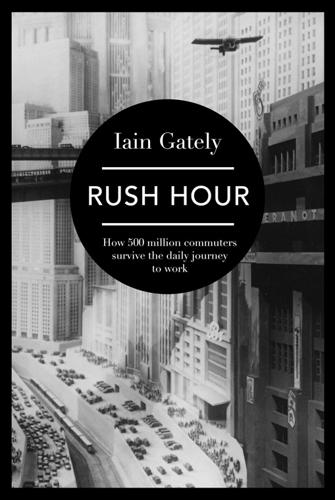
Rush Hour: How 500 Million Commuters Survive the Daily Journey to Work
by
Iain Gately
Published 6 Nov 2014
Sir James Hanson, the notorious British corporate raider of the 1980s, used to consider over-palatial head offices to be a sign that a company was ripe for takeover and asset stripping. However, his favourite symbol of corporate decadence – a duck lake – seems limited and quaint beside, say, Google’s current headquarters, the Googleplex in Santa Clara County, California. This behemoth has the skeleton of a T.rex; a replica of SpaceShip-One; two swimming pools; twenty-five cafés; a green building that uses recycled blue jeans for soundproofing; and random giant rubber balls, all crammed into its 56-acre lot. The food at the Googleplex is reputed to be spectacular. When Gourmet magazine investigated, it was impressed. Each café was ‘helmed by its own chef, most hailing from the world of fine dining’.

My Glorious Defeats: Hacktivist, Narcissist, Anonymous: A Memoir
by
Barrett Brown
Published 8 Jul 2024
I happened to know many of these memes because I served as an editor and contributor at a wiki called Encyclopedia Dramatica, which documented such things for posterity; it was the only writing I did for free. If we telescope in on just one of these elements, we can get a sense of how fractally baroque this culture was. Our spaceship—one of perhaps hundreds of thousands of scripted objects that Second Life players created for use in the world—was an exact replica of that used by a recurring set of characters from the postmodern animated series Aqua Teen Hunger Force: the alien Moonanites, themselves an homage to the aliens from the vintage Space Invaders video game.

Think Like a Rocket Scientist: Simple Strategies You Can Use to Make Giant Leaps in Work and Life
by
Ozan Varol
Published 13 Apr 2020
For decades, the acronym NASA represented the gold standard for thinking like a rocket scientist. Yet, after it blazed a trail to the New World, NASA largely handed off the human-spaceflight baton to others. In 2004, while the space shuttle was still grounded in the wake of the Columbia disaster, Burt Rutan’s SpaceShipOne became the first privately funded vehicle to reach space.8 Then, after the space shuttle was officially retired, NASA awarded SpaceX and Boeing contracts to build rockets to take American astronauts to the International Space Station. In a symbolic turn of events, SpaceX moved into Launchpad 39A and began launching its rockets from there.9 Blue Origin is building its own road to space with its rockets—called New Shepard and New Glenn—named after the first American space pioneers: the Mercury astronauts Alan Shepard and John Glenn.

In the Shadow of the Moon: A Challenging Journey to Tranquility, 1965-1969
by
Francis French
,
Colin Burgess
and
Walter Cunningham
Published 1 Jun 2010
When asked about this by the authors, Cooper’s face showed mixed emotions as he pondered the statement for a moment. “I suppose I wouldn’t disagree with it,” he finally responded. On Monday, 4 October 2004, the forty-seventh anniversary of the launch of the first Soviet Sputnik, a stubby experimental vehicle with the unpretentious name of SpaceShipOne shot into history, climbing to an altitude of 69.6 miles over California’s Mojave Desert with solo pilot Brian Binnie at the controls. When the spacecraft reached an altitude exceeding 62 miles for the second time in a week (the first flight in the same craft had been under the command of Mike Melvill) Binnie earned his astronaut wings.

Frommer's New Mexico
by
Lesley S. King
Published 2 Jan 1999
The first test flights took place in 2007, while the completion date for the spaceport is 2011. When it’s complete, Branson plans to headquarter Virgin Galactic here. Currently Virgin is selling tickets for $200,000 apiece for a 21⁄2-hour flight, including 5 minutes of weightlessness. The first of these flights will likely fly out of the Mojave Airport in California, where SpaceShipOne became the first privately manned rocket to reach space in 2004. For updates, log onto www. virgingalactic.com or www.edd.state. nm.us. 315 SOUTHWESTERN NEW MEXICO Truth or Consequences 11 Taking the Waters at the Historic Hot Springs The town’s “original” attraction is its hot springs. The entire downtown area is located over a table of odorless hot mineral water, 98° to 115°F (37°–46°C), that bubbles to the surface through wells or pools.

Southwest USA Travel Guide
by
Lonely Planet
Space tourism may well involve a simple 62-mile (straight up) add-on to your New Mexico vacation package. For just $200,000, you can book your flight on VSS Enterprise online for a 90-minute ride in a plush cruiser with reclining seats, big windows and a pressurized cabin so you won’t need space suits. The vessel is designed by legendary aerospace engineer Bob Rutan, whose SpaceShipOne was the first privately funded (by Microsoft cofounder Paul Allen) manned vehicle to reach outer space twice in a row, winning him the $10 million 2004 Ansari X-Prize. It’s not all about tourism, however. Spaceport America has been used by UP Aerospace to launch cheap cargo carriers into low Earth orbit since 2006 and has banked over a million dollars in deposits for future scientific research trips.

California
by
Sara Benson
Published 15 Oct 2010
To the southeast, Edwards Air Force Base ( 661-277-3510; www.edwards.af.mil) is a flight-test facility for the US Air Force, NASA and civilian aircraft, and a training school for test pilots with the ‘right stuff.’ Chuck Yeager piloted the world’s first supersonic flight here, and it was here the first space shuttles glided in after their missions. In 2004 SpaceShipOne became the first civilian aircraft to reach suborbital altitudes here – twice. Public tours of the on-base flight museum and NASA research center are usually given on the first and third Fridays of the month; for reservations, contact the public affairs office a few weeks in advance. Return to beginning of chapter BORON pop 2030 / elev 2355ft Off Hwy 58, about midway between Mojave and Barstow, this tiny town got its start when rich deposits of borax were found underground here in 1927.

Rationality: From AI to Zombies
by
Eliezer Yudkowsky
Published 11 Mar 2015
The Constant Fire quotes William James’s The Varieties of Religious Experience as saying: Religion . . . shall mean for us the feelings, acts, and experiences of individual men in their solitude; so far as they apprehend themselves to stand in relation to whatever they may consider the divine. And this theme is developed further: Sacredness is something intensely private and individual. Which completely nonplussed me. Am I supposed to not have any feeling of sacredness if I’m one of many people watching the video of SpaceShipOne winning the X-Prize? Why not? Am I supposed to think that my experience of sacredness has to be somehow different from that of all the other people watching? Why, when we all have the same brain design? Indeed, why would I need to believe I was unique? (But “unique” is another word Adam Frank uses; so-and-so’s “unique experience of the sacred.”)
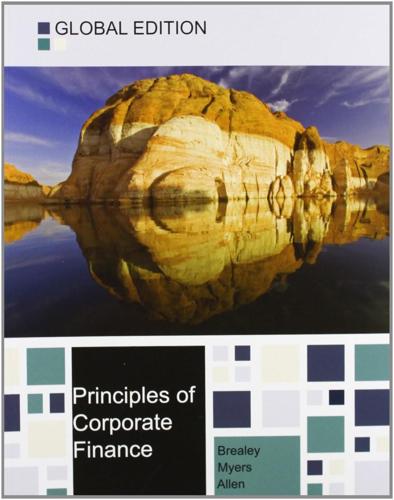
Principles of Corporate Finance
by
Richard A. Brealey
,
Stewart C. Myers
and
Franklin Allen
Published 15 Feb 2014
But in well-functioning capital markets, shareholders will vote for only one of these goals. Which one? Why? 8. Maximizing shareholder value Ms. Espinoza is retired and depends on her investments for her income. Mr. Liu is a young executive who wants to save for the future. Both are stockholders in Scaled Composites, LLC, which is building SpaceShipOne to take commercial passengers into space. This investment’s payoff is many years away. Assume it has a positive NPV for Mr. Liu. Explain why this investment also makes sense for Ms. Espinoza. 9. Ethical issues The box on page 11 describes the controversial involvement of Goldman Sachs in a financing deal with Greece.